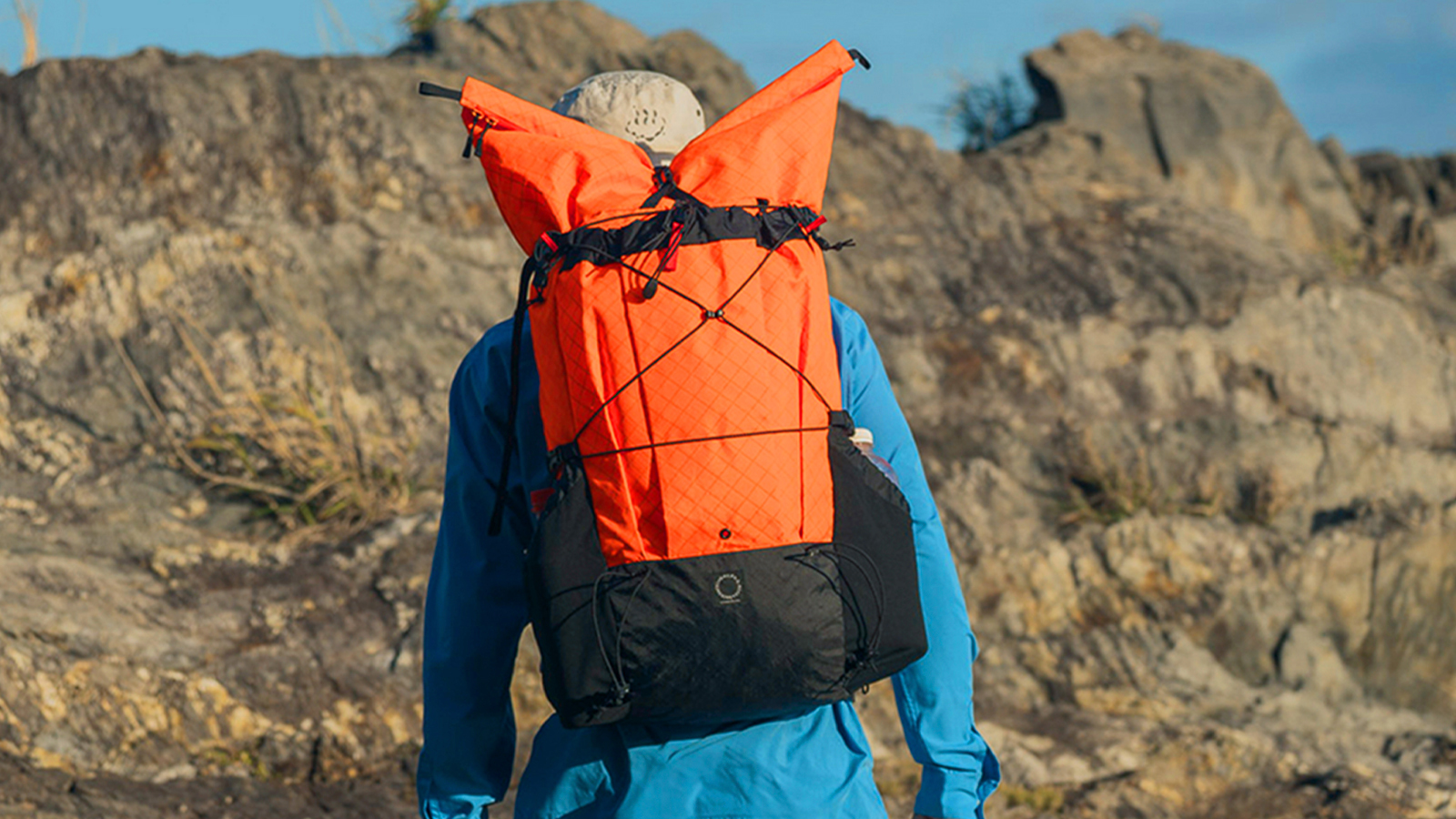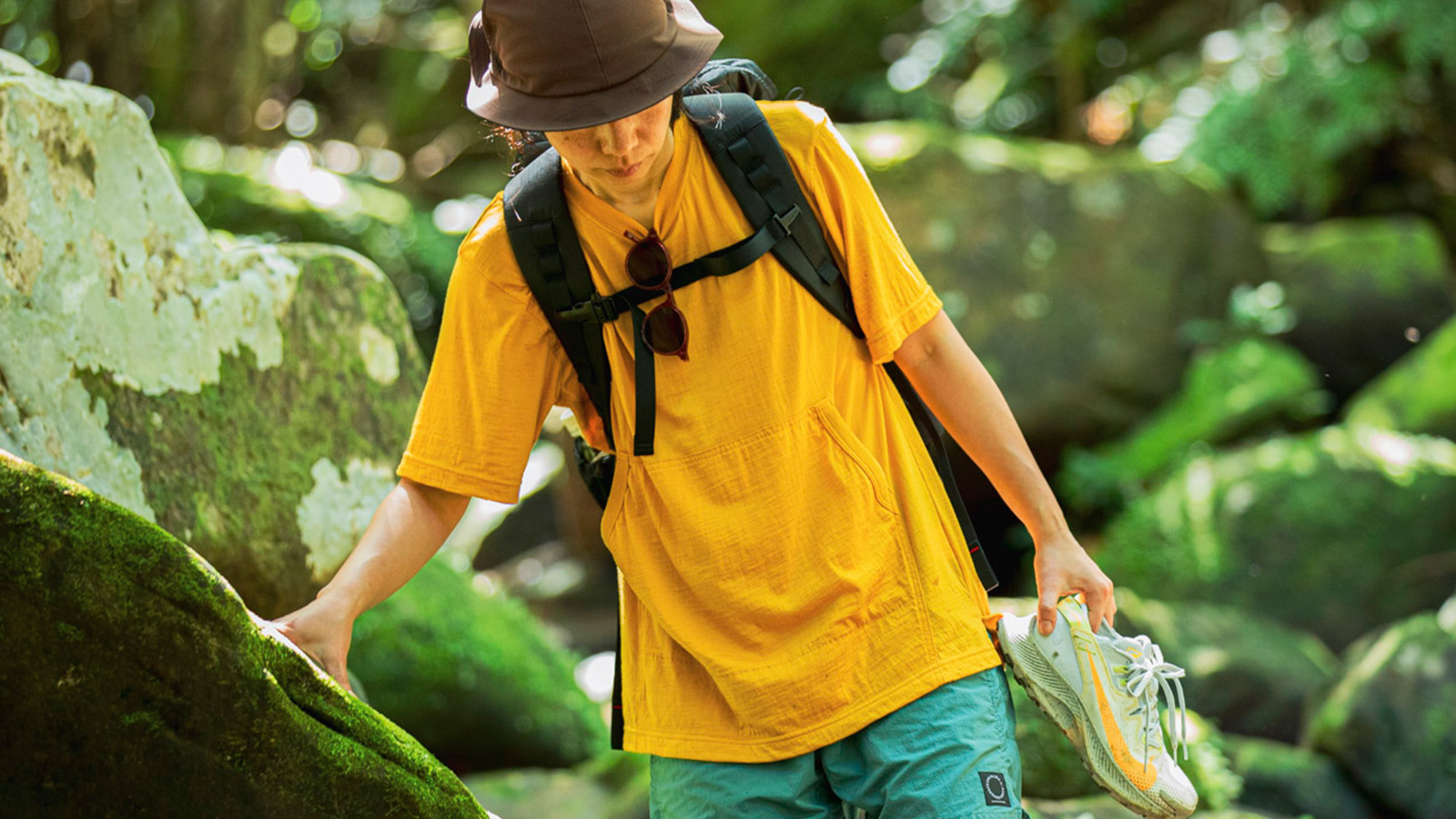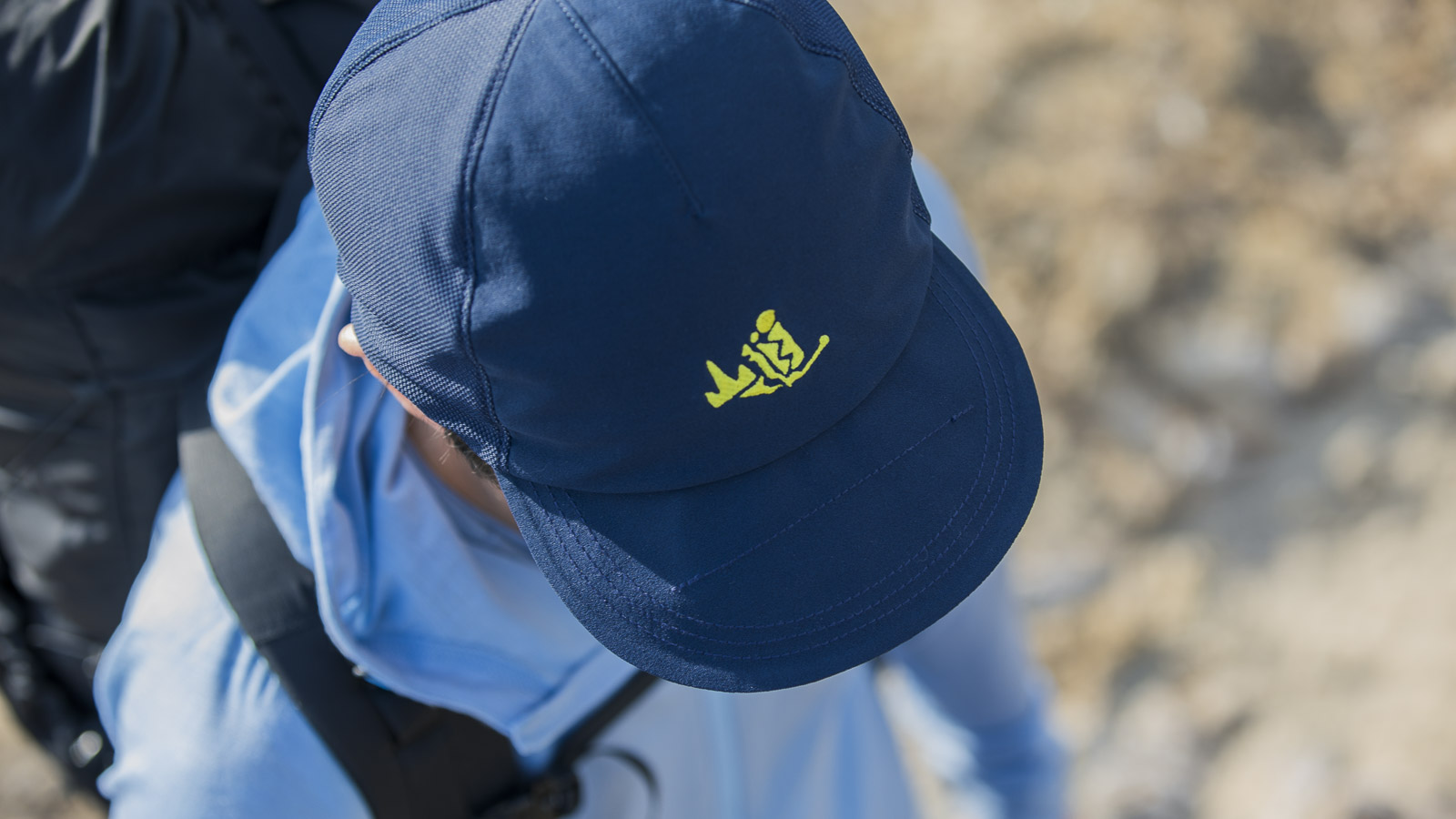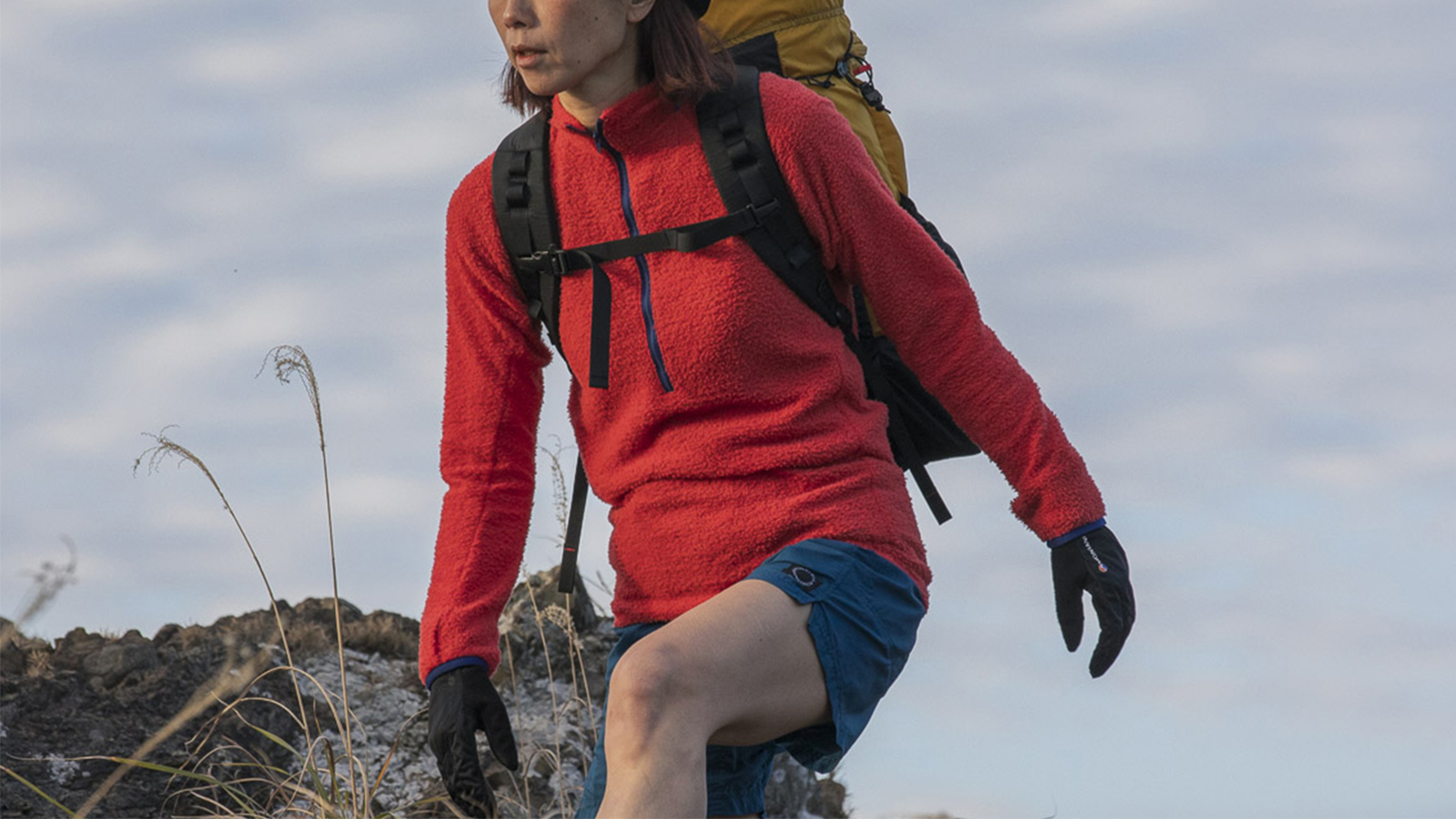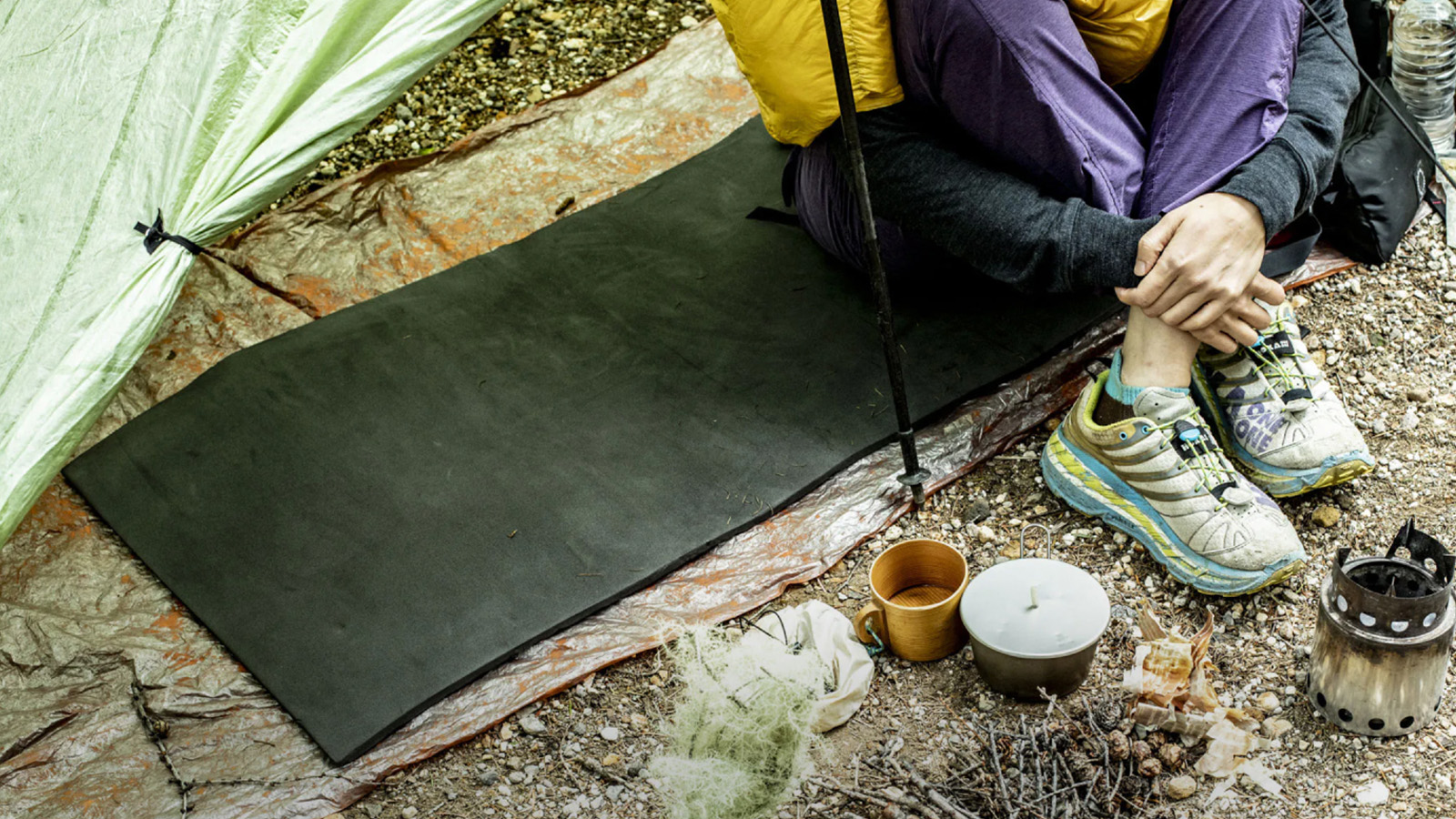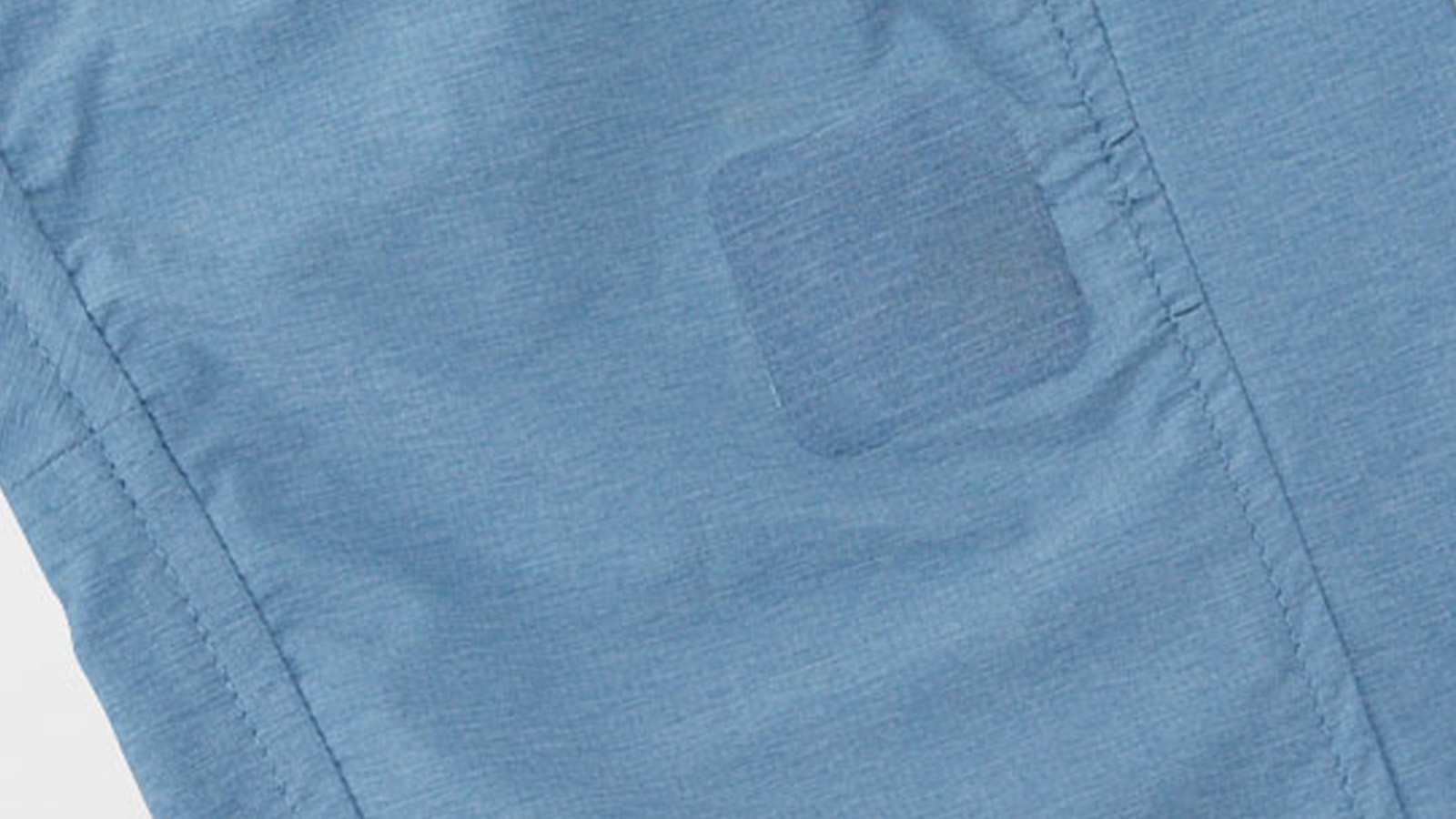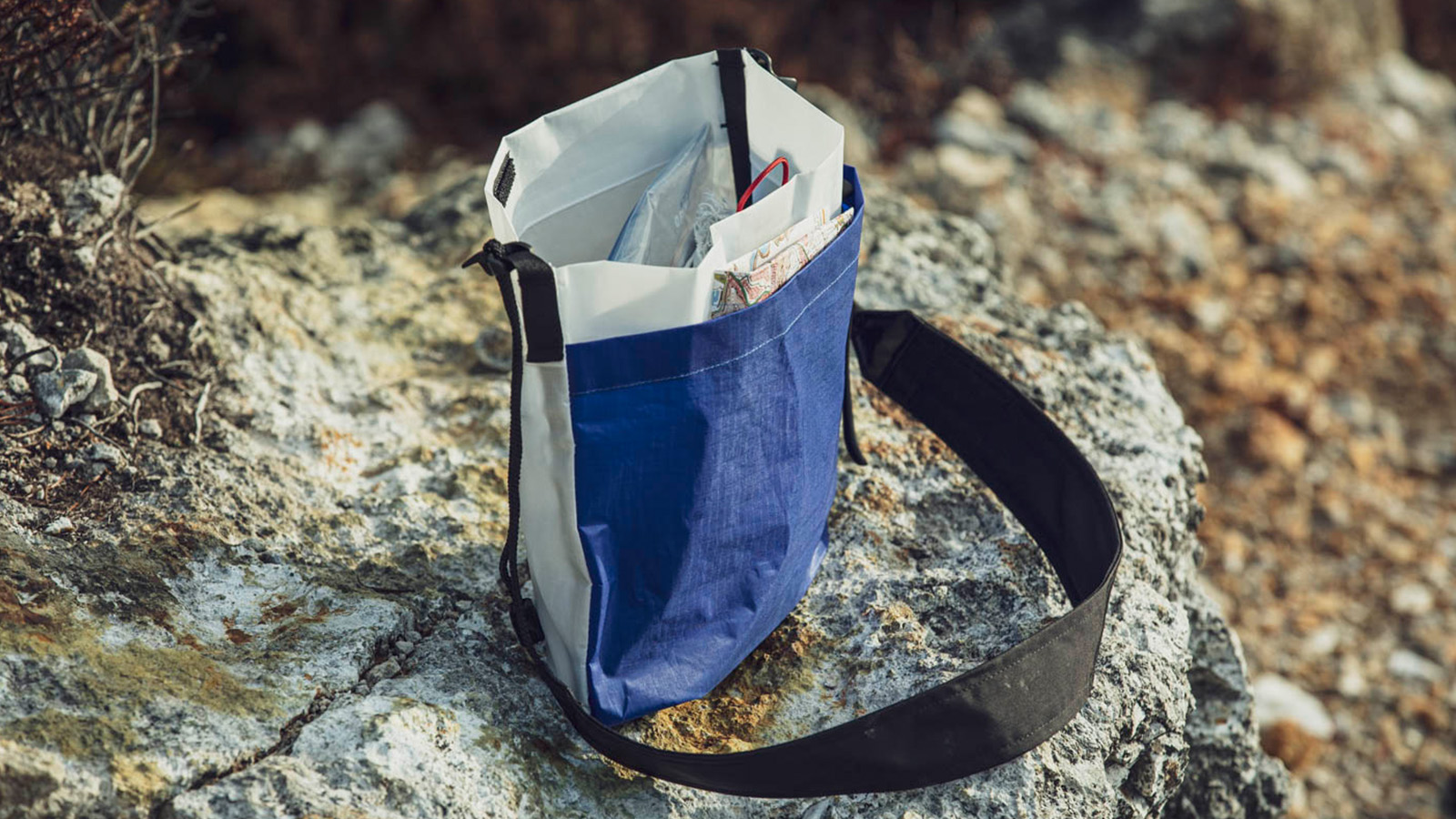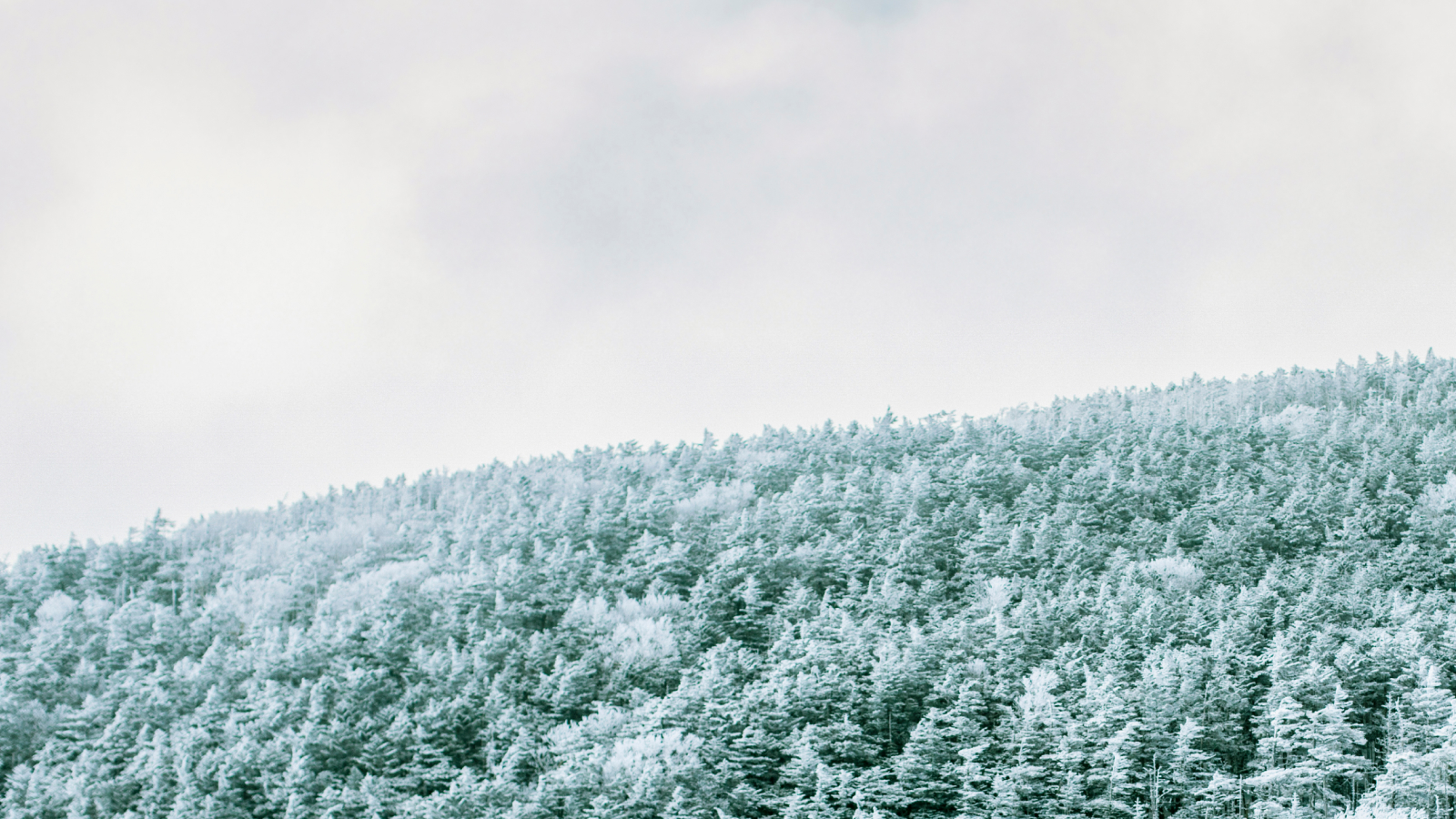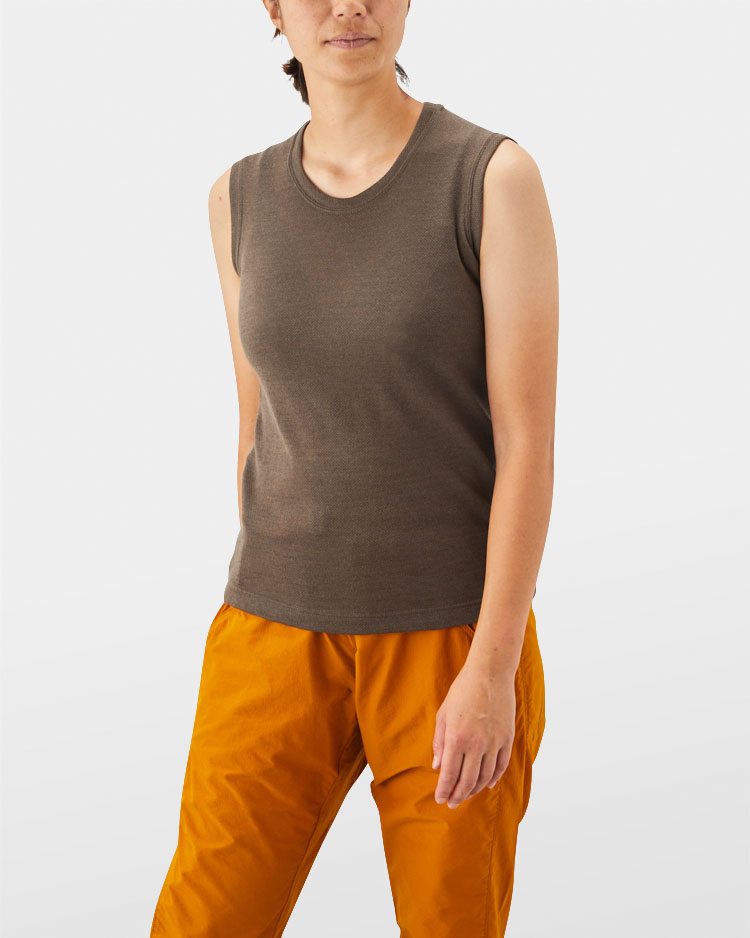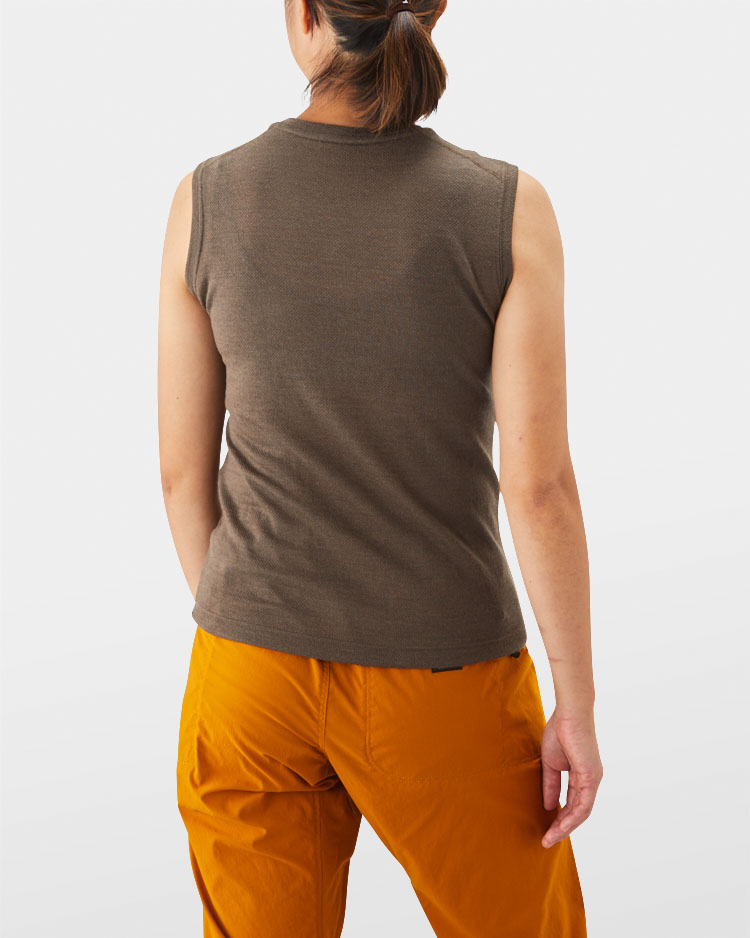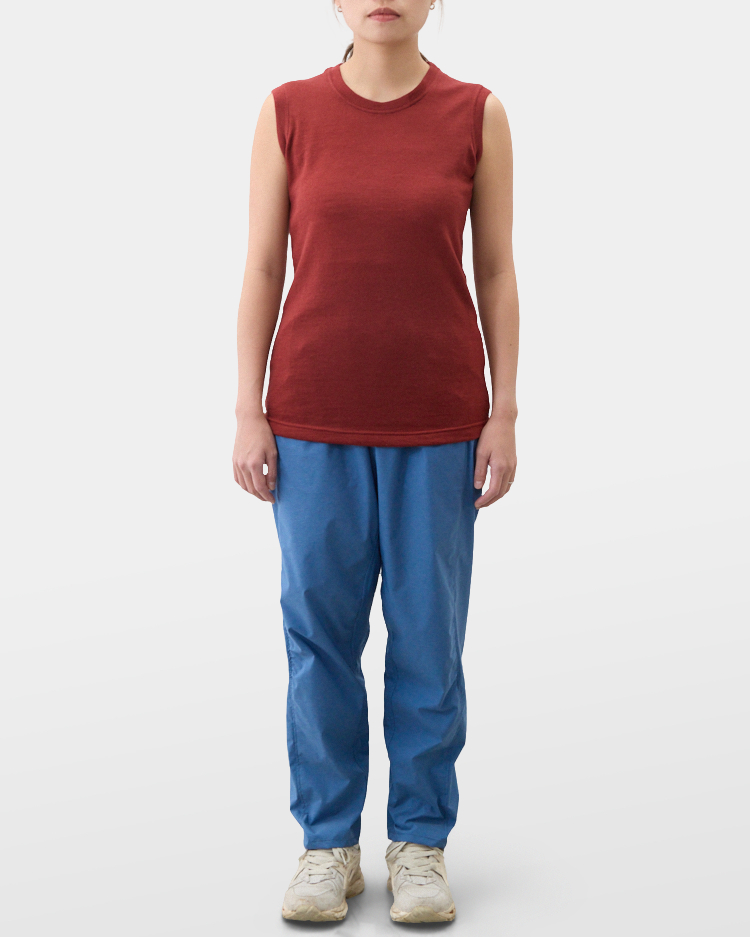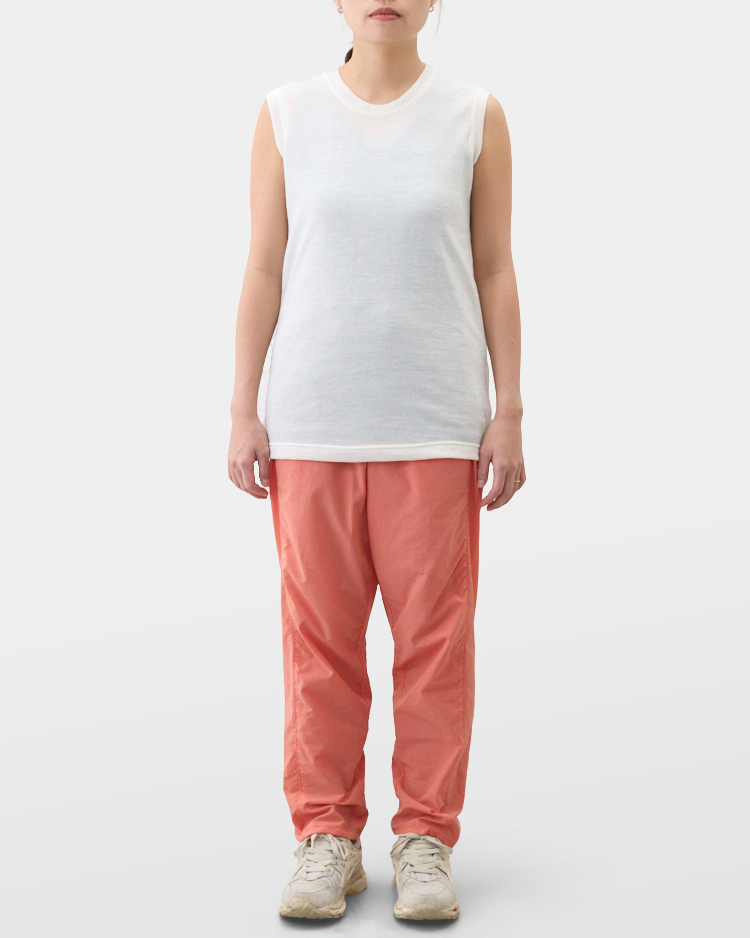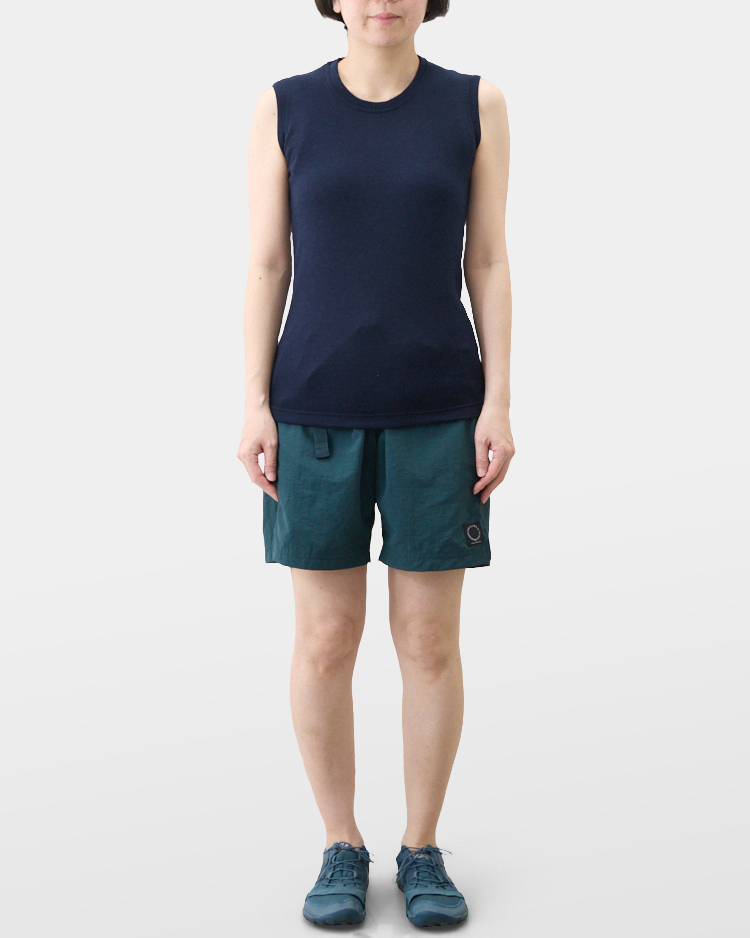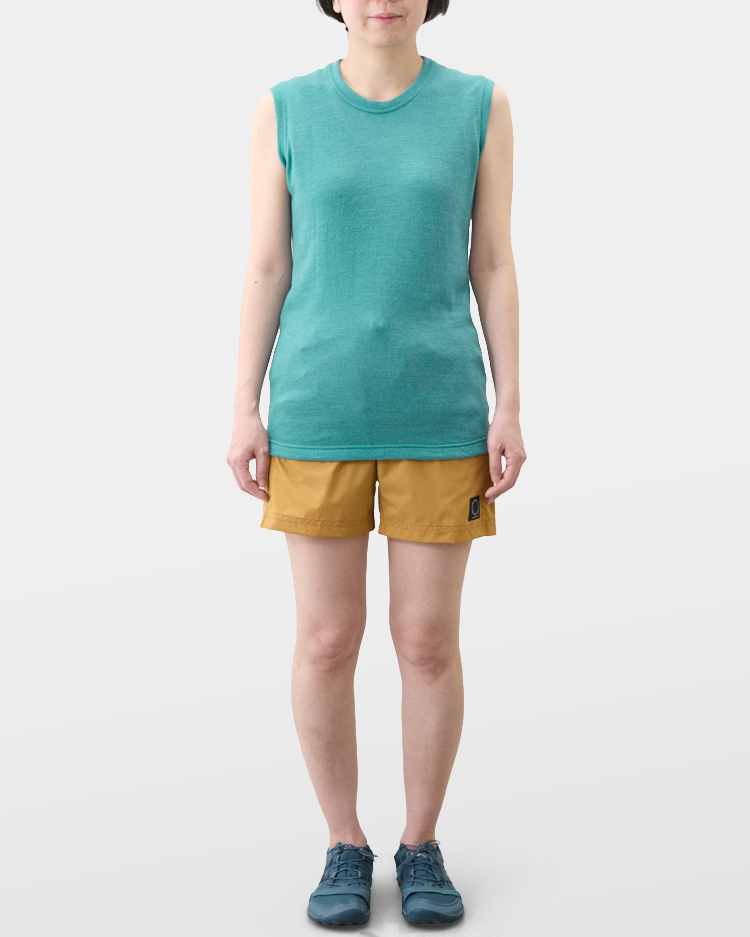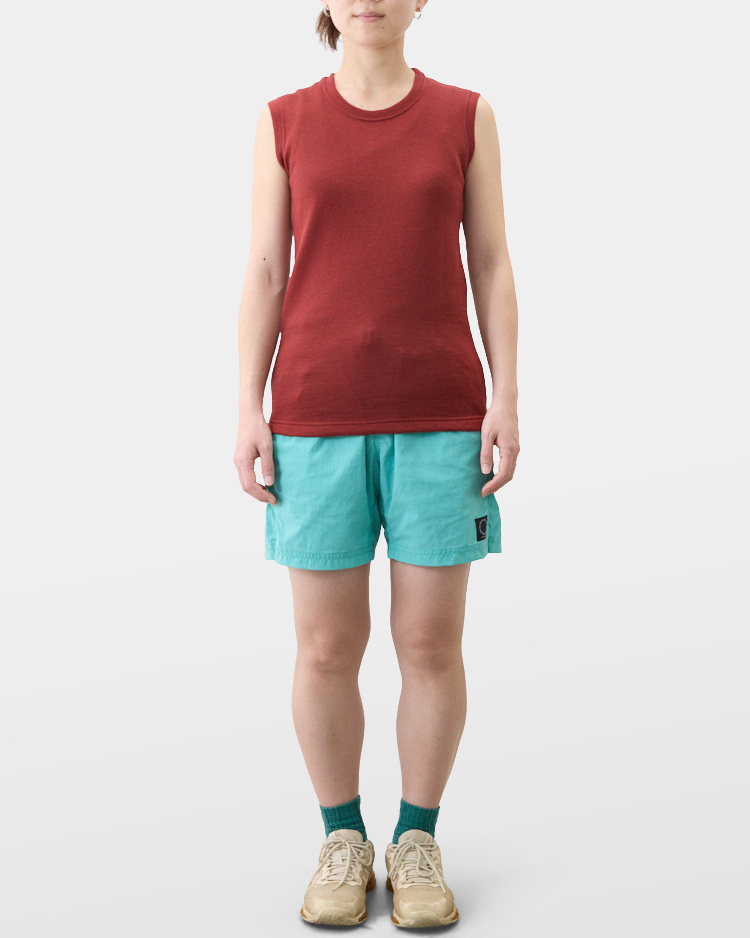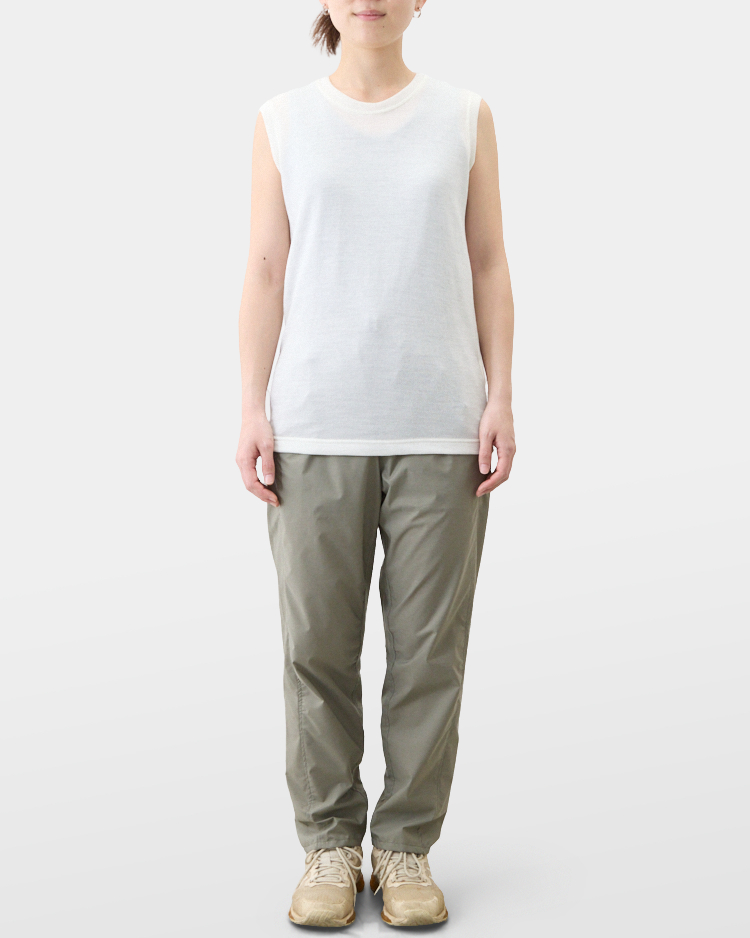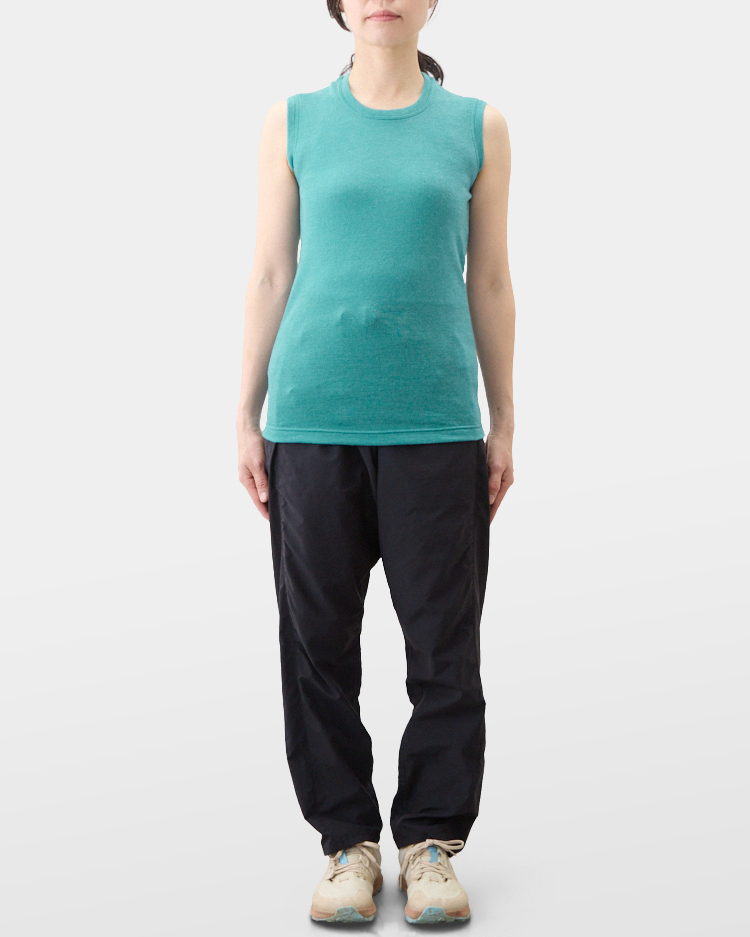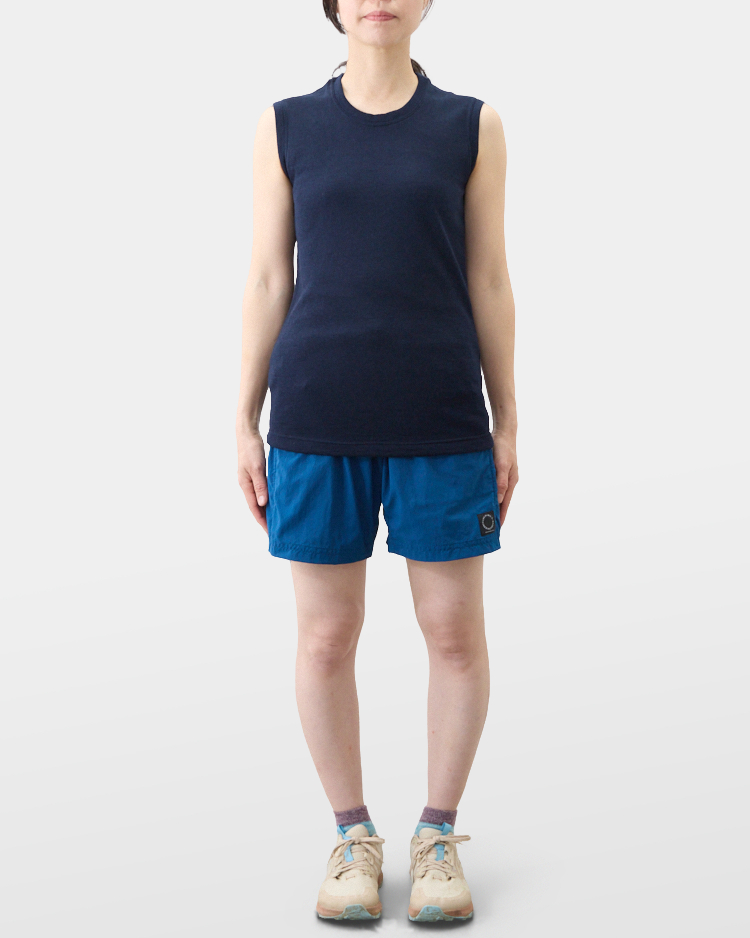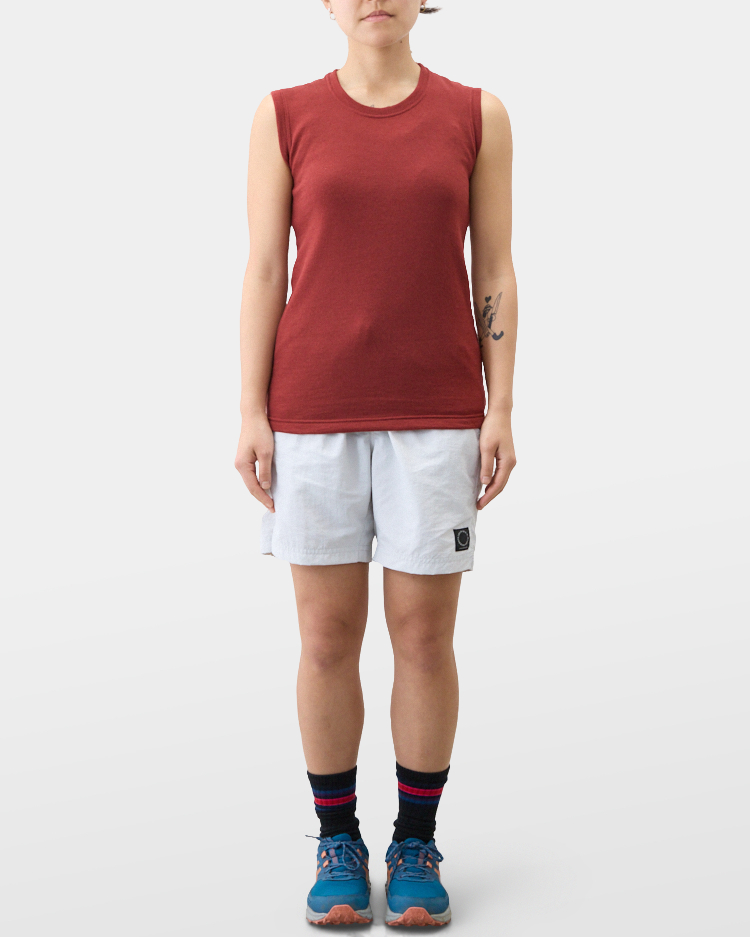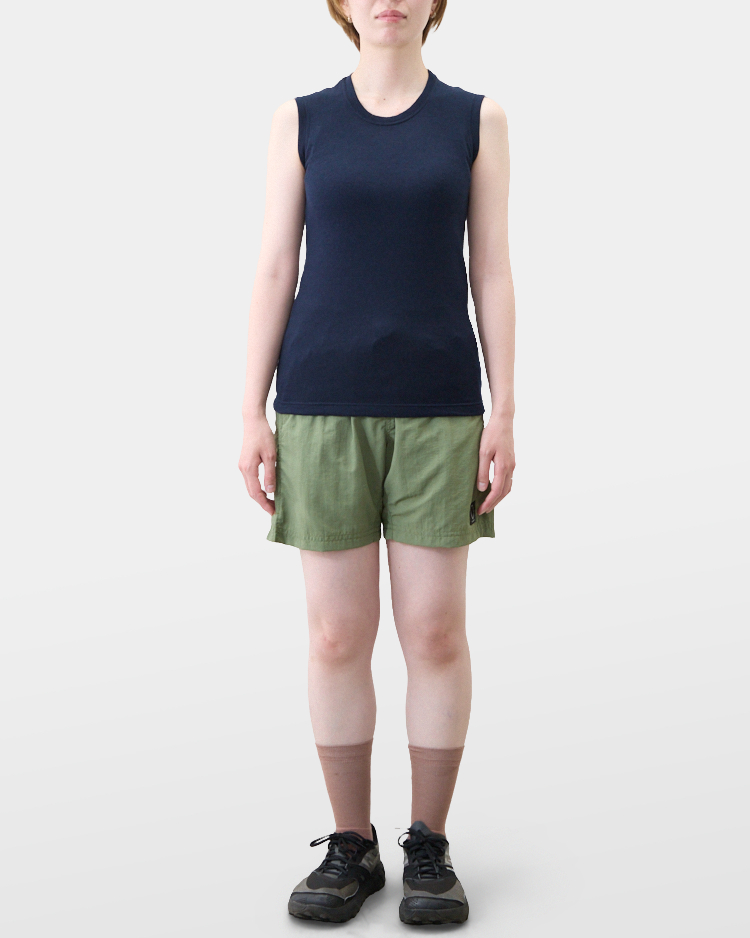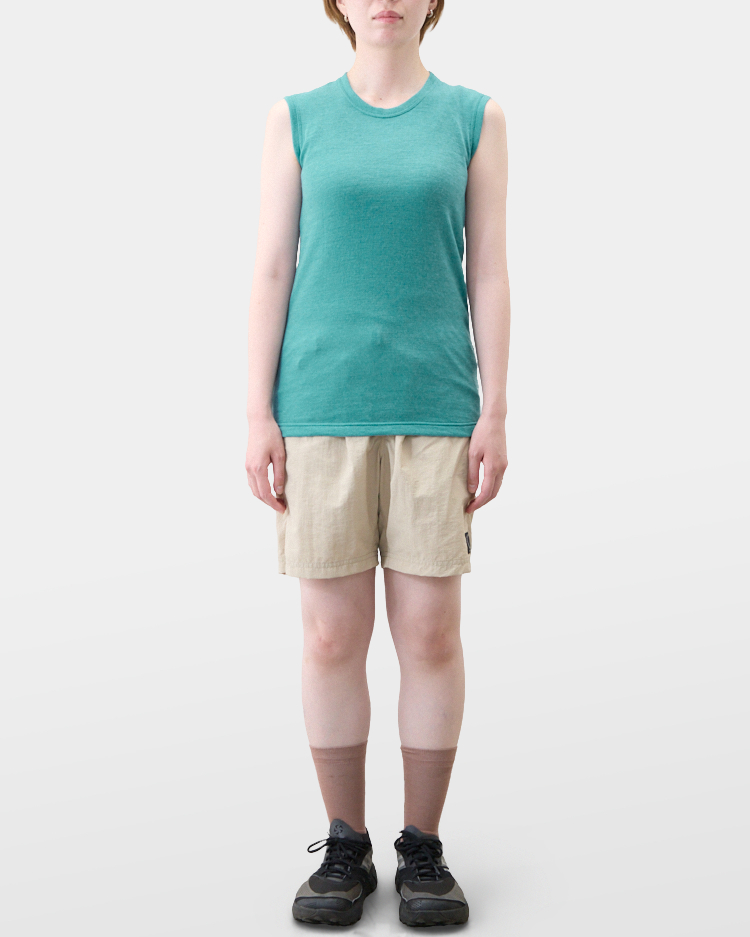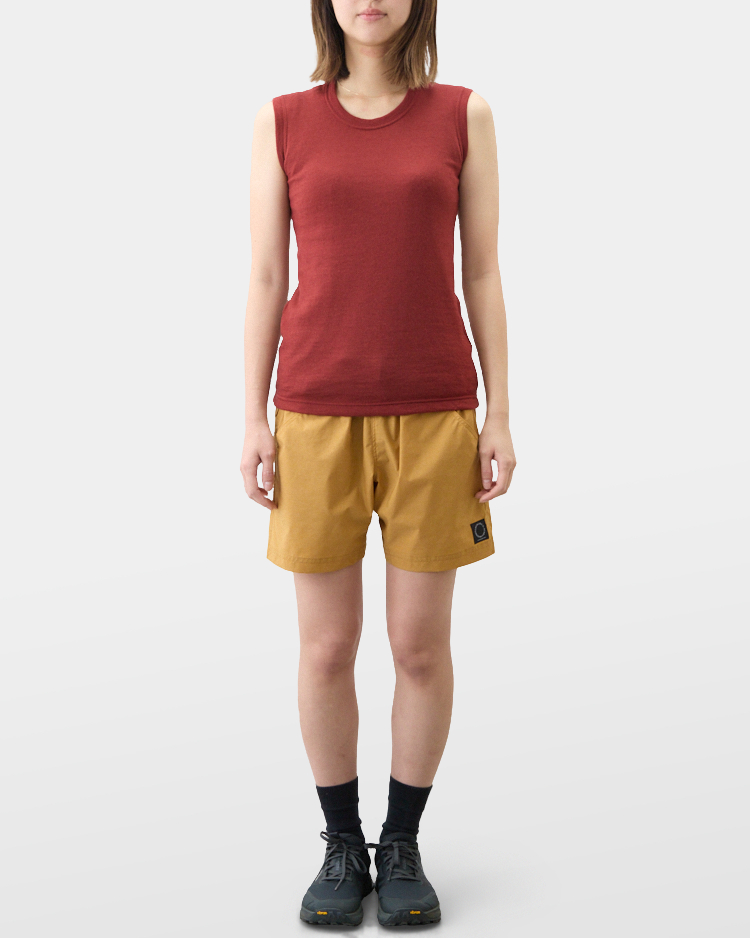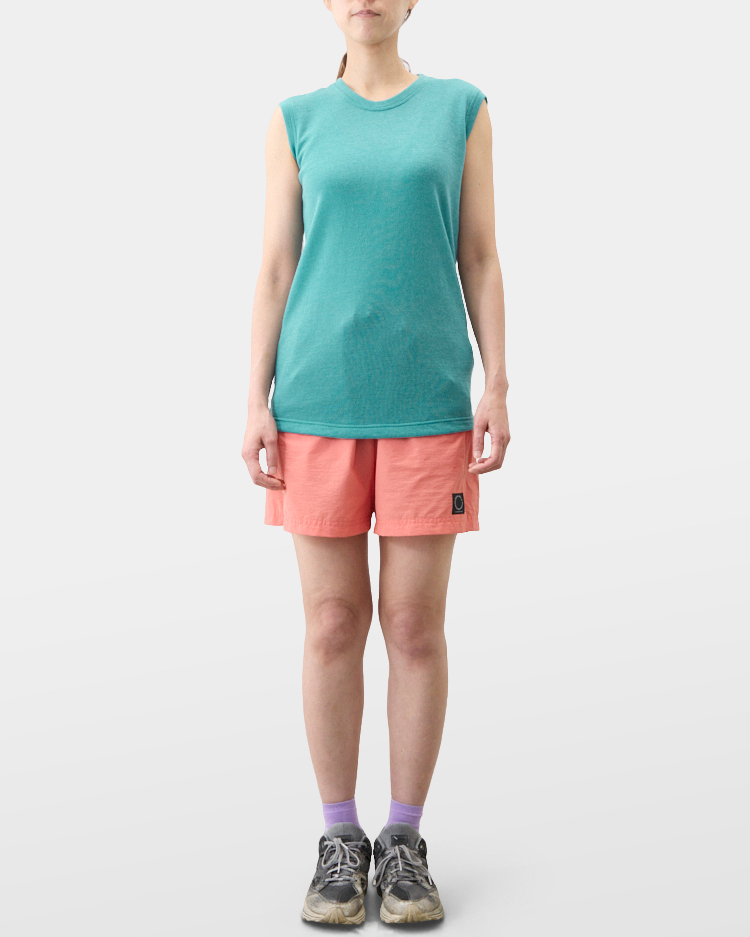95g (Size M)
103g (Size L)
- Introduction
- Beyond Merino
- Product story
- Overcoming wool’s drawbacks
- Form and function
- Breathable
- Advanced Moisture Control with Double-Face Merino
- Fast-drying
- Recommended Scenes
- DF Mesh Merino: comparative testing vs. 100% Merino
- Positioning among the base layers
- Merino Wool's advantages
- Wool's disadvantages
- Details
- Product review
- Material
- Size guide
- Note before use
- Durability
- Potential color transfer
- Instructions
- Care instructions
- Repair
Introduction
Beyond Merino
The DF Mesh Merino series is our proprietary base layer series that outperform our 100% Merino wool lineup, minimizing the drawbacks in many respects such as merino’s slow drying, the tendency for stickiness, and heat-buildup.
DF stands for “double face”; the skin side is hydrophobic-finished to quickly dispense of any moisture (sweat), while the surface is hydrophilic-finished so that the fabric absorbs the released sweat, keeping your skin feeling dry. It offers maximum comfort even under changing weather or when performing intensive and sweaty exercise. The DF fabric also has superior deodorant properties and moisture-control performance naturally derived from merino wool.
While keeping the natural advantages of wool, such as comfortability, deodorizing, and moisture control properties, this new hybrid fabric is highly breathable, yet retains your body heat when layered with a shell jacket, and even if you sweat, the mesh-like material reduces skin irritation and dries quicker than conventional wool.
With excellent stretch and freedom of movement, the fabric is tailored in a slim fit to keep sweat close to the surface and away from the skin.
Please note that the mesh wool fabric can be prone to snag and piling especially when rubbed against backpacks.
Product story
Overcoming wool’s drawbacks
We consider merino wool to be the best base layer fabric for hiking because it doesn’t smell even after a week of wear. There are, however, those who disagree.
Some say that it gets too hot during highly intensive activities such as hiking or running, that it sticks to the skin when wet with sweat and makes it difficult to move, or that it dries slower than synthetic fabrics.
Yes, we have to admit that merino wool is not flawless.
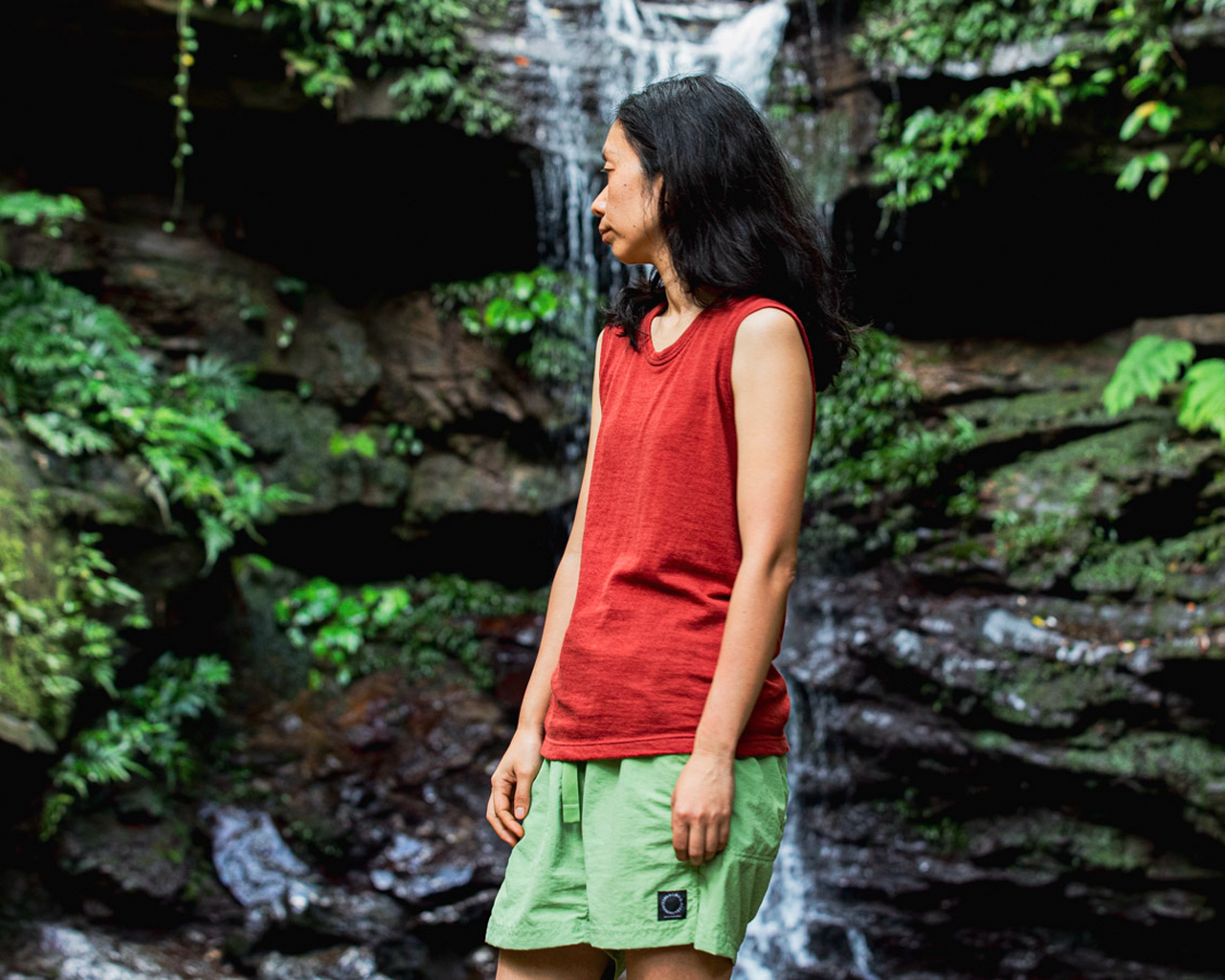
Kiyora Toyoshima, wearing the Brick Red color.
I myself have had the experience of wearing a sweat-soaked merino wool T-shirt that would not dry at the tent site. I was putting it on while sleeping to make it dry. I do love merino wool but sometimes wished it would dry a little faster.
So we decided to create a “super merino wool” for hiking by adding the advantages of synthetic fibers, such as air-permeability, quick-drying property, and comfortable texture even when wet.
From the beginning of the development, our aim was to create a “breathable mesh merino wool” product. However, we wanted something even better. That is, we wanted a hydrophobic mesh and merino wool fabric in a single piece, but it should not look like a mesh fabric at a glance so that it could be worn by itself. Of course, there were many challenges. Our first prototype had the mesh surface on the front, but we later reversed the front and back; This made the mesh fabric come into contact with your skin by multiple points rather than by one large surface. The front side was made flat to increase durability.
We also developed two types of proprietary merino wool yarns; hydrophobic yarn to repel water and hydrophilic yarn to absorb water, which allowed quick absorption and wicking.
As explained in the “Form and Function” section of this webpage, this combination of two types of yarns resulted in the DF Mesh Merino series, successfully overcoming the drawbacks of wool fabric.
To tell the truth, however, the development was not as easy-going as it seems. It took a long time and effort to test, mass-produce and verify the quality and stability.
We spent a long time field testing it as well as at the inspection agency, and the theoretical verification of the fabric. I, of course, tested the fabric myself too. Is the DF a solution for merino wool’s drawbacks? To find the answer, more than 20 testers participated in our field test, and though the majority of feedback was favorable, we pinpointed two concerns.
The two concerns were the mesh fabric’s low durability and the heating performance due to the thickness of the fabric. The good air permeability should make you comfortable at the mountain ridge where the wind is blowing, but you may feel a little too warm at low-altitude mountains in the mid-summer.
That said, the DF performed surprisingly well in the high-altitude mountains where the temperature drastically changes. As I kept hiking the steep uphill during the onsite test, the DF Mesh Merino got sweat-soaked but was instantly dried by the wind blowing at the mountain ridge.
We proudly recommend the DF for merino lovers as well as synthetic base layer users who dislike the wool’s conventional drawbacks. After many trials and errors, we are finally ready to release this exciting new product to you. (Updated 2022)
Form and function
Breathable
The DF Mesh Merino series has a mesh structure to accelerate the air-permeability. It is far more breathable than the conventional merino fabrics, keeping you dry and cool even when performing intensive and sweaty exercises.
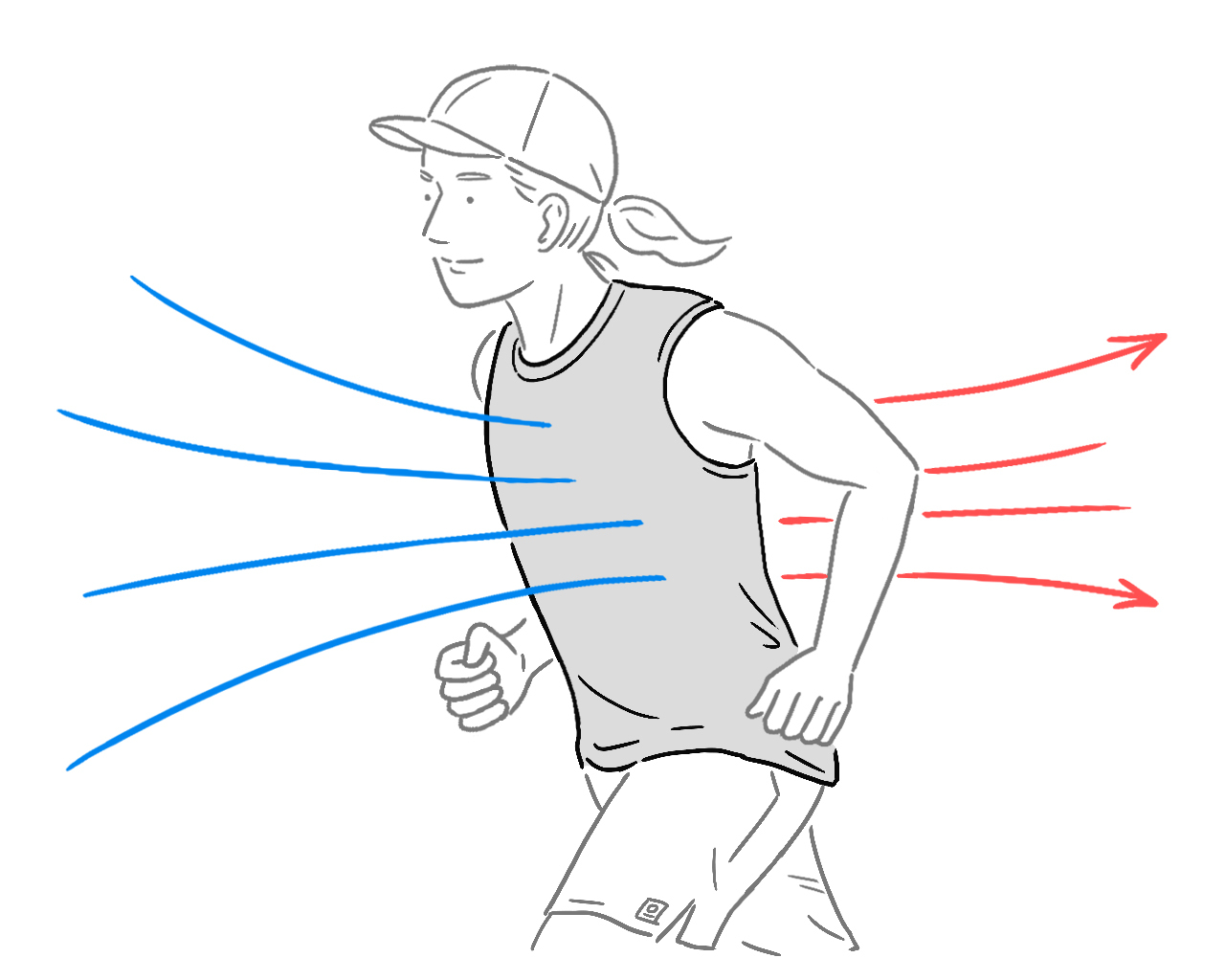
Advanced Moisture Control with Double-Face Merino
The inner layer is made from 100% merino wool yarn for a soft, comfortable feel against the skin. It’s knitted into a mesh structure that touches the skin at points, reducing discomfort when damp with sweat.
Additionally, the skin-facing side is treated with a hydrophobic finish to repel moisture, while the outer surface has a hydrophilic finish to enhance sweat absorption. This double-face (DF) construction quickly wicks moisture away from the skin, helping to prevent stickiness and maintain lasting comfort.
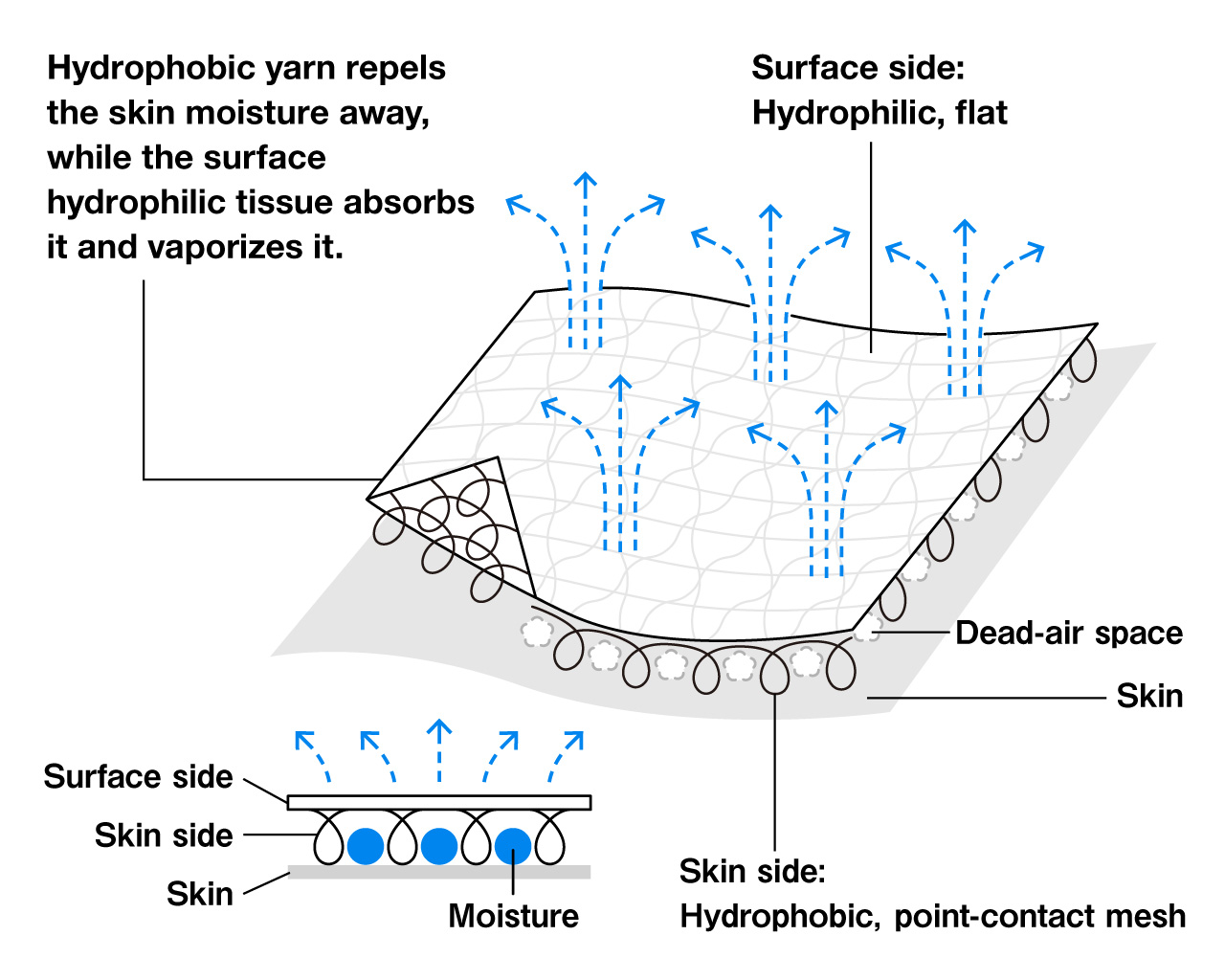
Fast-drying
The DF Mesh Merino’s fast-drying properties outperform the conventional merino fabric, preventing you from being cold from your own sweat because of the slow-drying fabric.
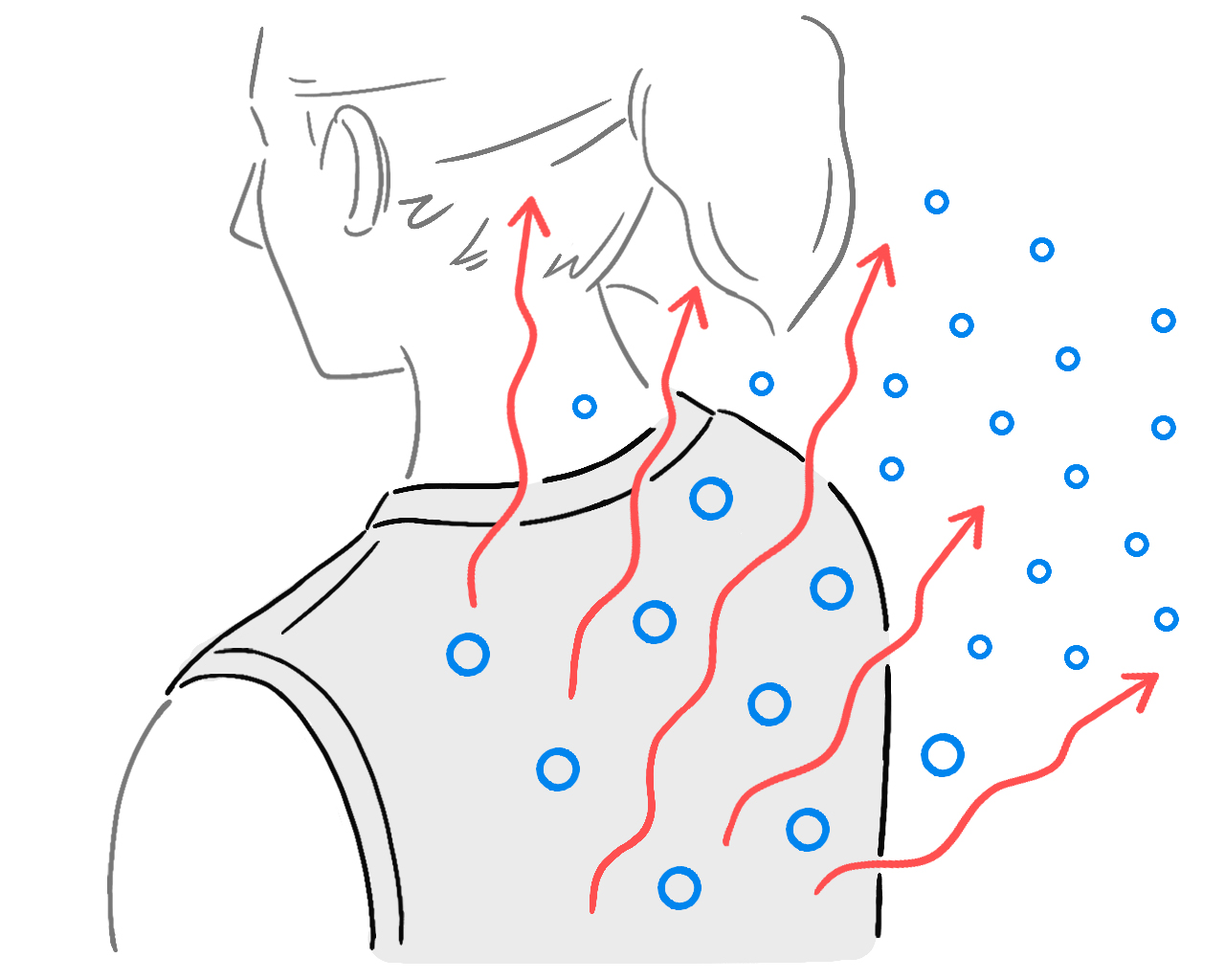
Recommended Scenes

Hiking
The DF series is suitable for various temperature zones and perfect for long-term and multi-seasonal mountain hikes.
The synthetic fabrics can be smelly for several hours after you sweat, even when they are deodorant finished, and you don’t want to wear them the next day. On the other hand, our DF Mesh Merino has a high percentage of the wool mixture and thus has a powerful and natural anti-odor performance.
It is also fast-drying and can be worn for many hours and even days without washing, reducing the need for extra changes in your backpack.
※When worn with a backpack with substantial weight, fabric pilling, holes, and fraying are more likely to occur. Therefore, we recommend layering with a shirt or jacket to minimize these issues.
Trail Running, Fast Packing
The DF series’ elastic fabric smoothly follows your dynamic movements and is perfect for intensive and sweaty exercises such as trail running and fast packing.
The highly absorptive dual-layer mesh fabric will keep you dry even when you sweat heavily. It is also lightweight and less likely to gain weight as it dries quicker than normal wool fabrics. The highly air-permeable fabric will let the wind pass and keep you cool when worn by itself, while it is warm if you wear it under a shell jacket. It is perfect when you need both thermal performance AND sweat/heat permeability.
Please note that it is warm, and you may feel it’s too warm at low-altitude mountains in mid-summer.
In bad weather with changing temperature
The dual-layer DF Mesh Merino is highly air-permeable and will keep you cool when it’s hot, while quickly warming you up if you wear it below a light shell jacket.
It is warm even when soaked with rain because it is made of wool with humidity-control performance and heat-generating properties. It is especially suitable under severe conditions with large temperature differences between day and night, mountaineering from low to high altitudes, and climbing where inclement weather is expected.
DF Mesh Merino: comparative testing vs. 100% Merino
The DF Mesh Merino performs better than our conventional 100% Merino fabrics in many respects; According to our in-house test result, the DF’s air permeability is approximately three times as 100% Merino fabric, 2.5 times as fast-drying, and 1.4 times as heat-retentive. In addition, the fabric has a high level of humidity control and odor resistance, which are derived from natural wool.
However, the wear resistance is, on the other hand, only 40% of our conventional 100% Merino fabrics, with almost equal burst strength, meaning that the DF can easier develop snags, pillings, and holes.
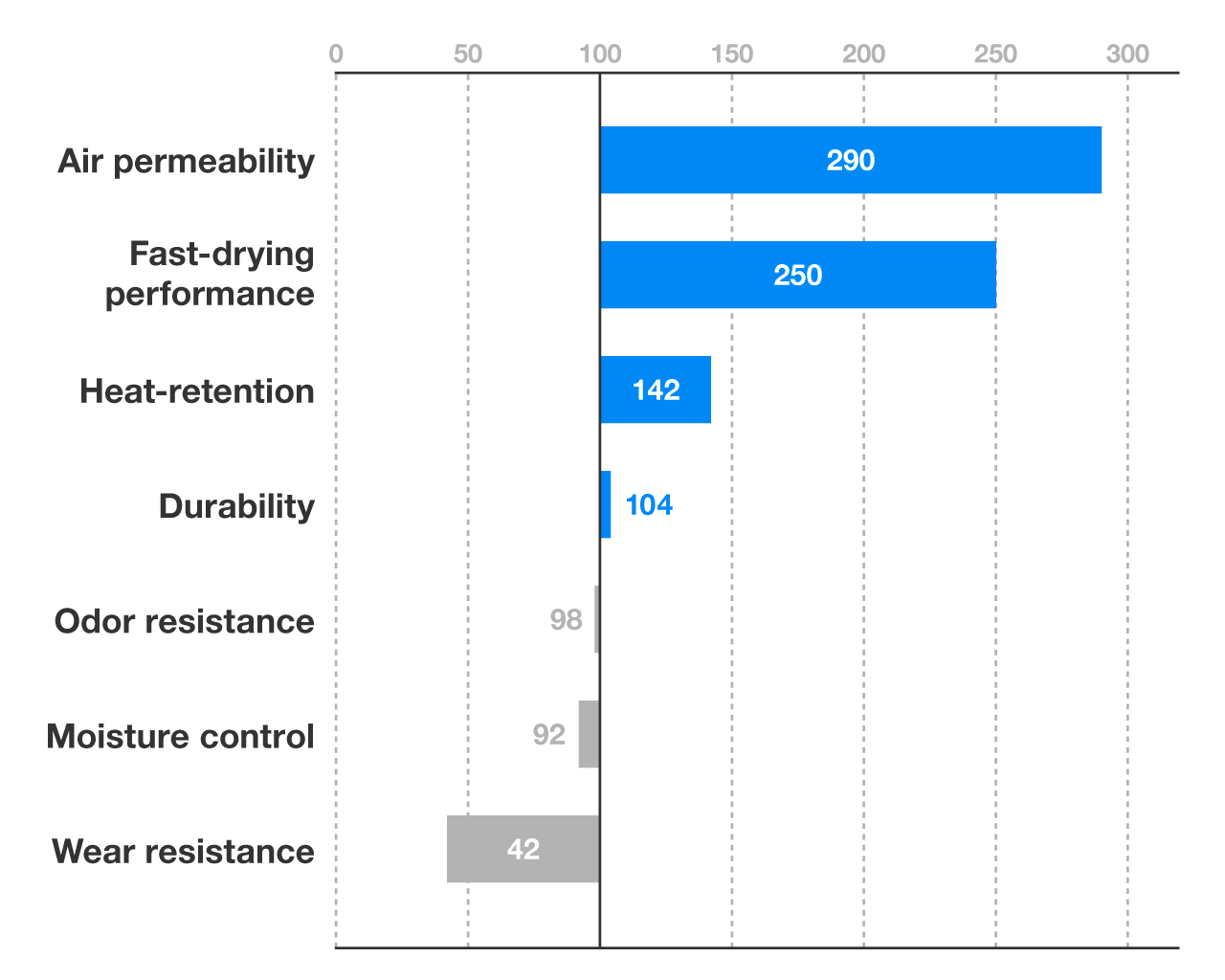
The measurements above are based on the unwashed product at the time of purchase.
- Due to the nature of stretchable knit fabric and slight variations in sewing, actual dimensions may differ slightly from the listed sizes.
- The fabric may stretch with wear and shrink after washing. The amount of change can vary between individual garments.
- Shrinkage may also vary depending on the type of washing machine and the settings used.
- If the garment feels smaller after washing and drying, you can help restore its shape by gently stretching it while using a steam iron.
Positioning among the base layers
In general, quick-drying performance and moisture absorption or cooling performance, and heat retention performance are inversely related, with one being higher and the other lower.
The DF Mesh Merino, however, achieves these contradicting properties at the same time; Quick-drying AND moisture absorptive, cool AND warm. The DF demonstrates high functionality in areas where synthetic base layers with superior quick-drying and cooling performance have excelled.
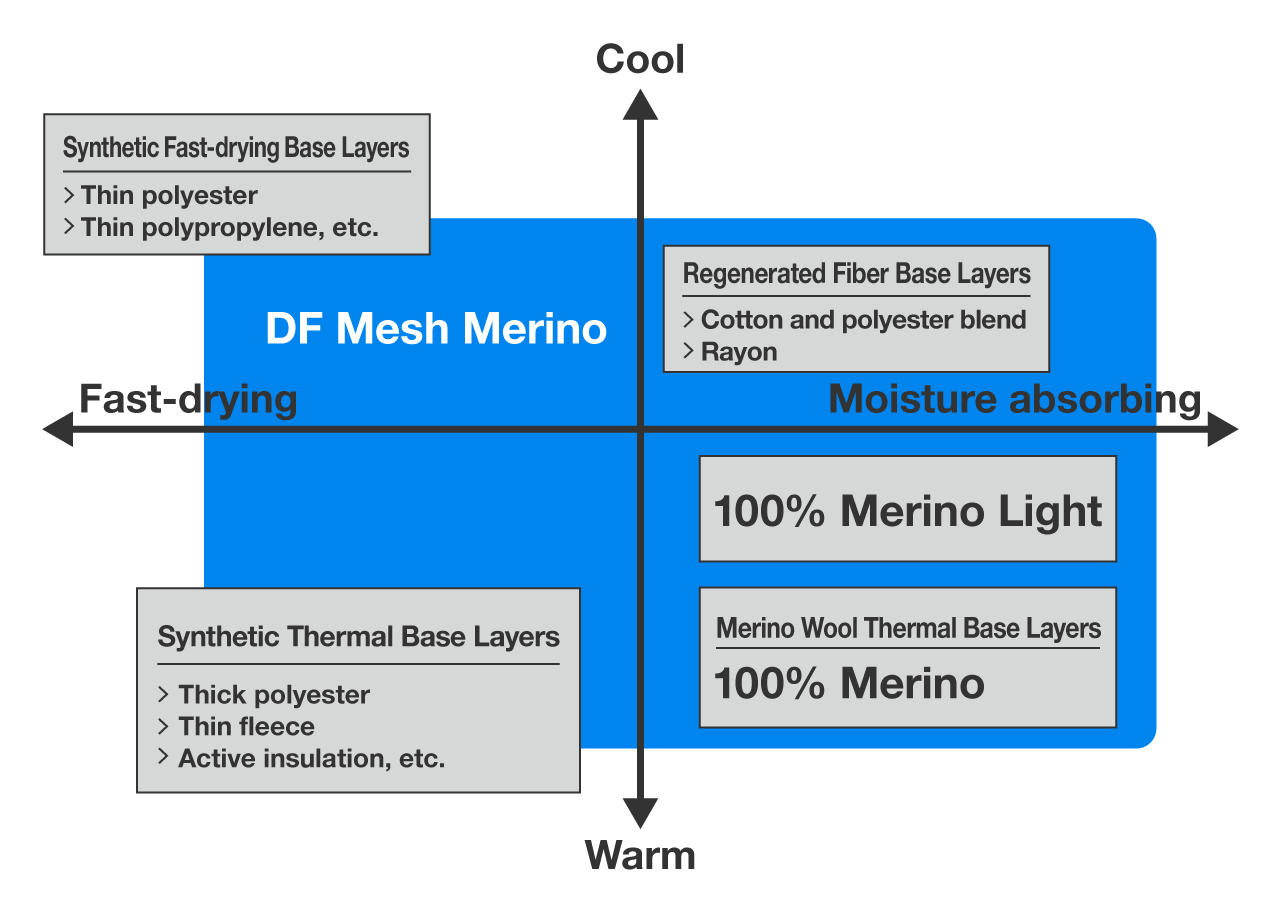
Merino Wool's advantages
Naturally odor resistant
Wool base layers are chosen by many hikers for the material’s excellent odor-neutralizing performance. Some say it’s almost odor-free even after a week of heavy hiking, but we’ll let you (and your friends) be the judge of that…
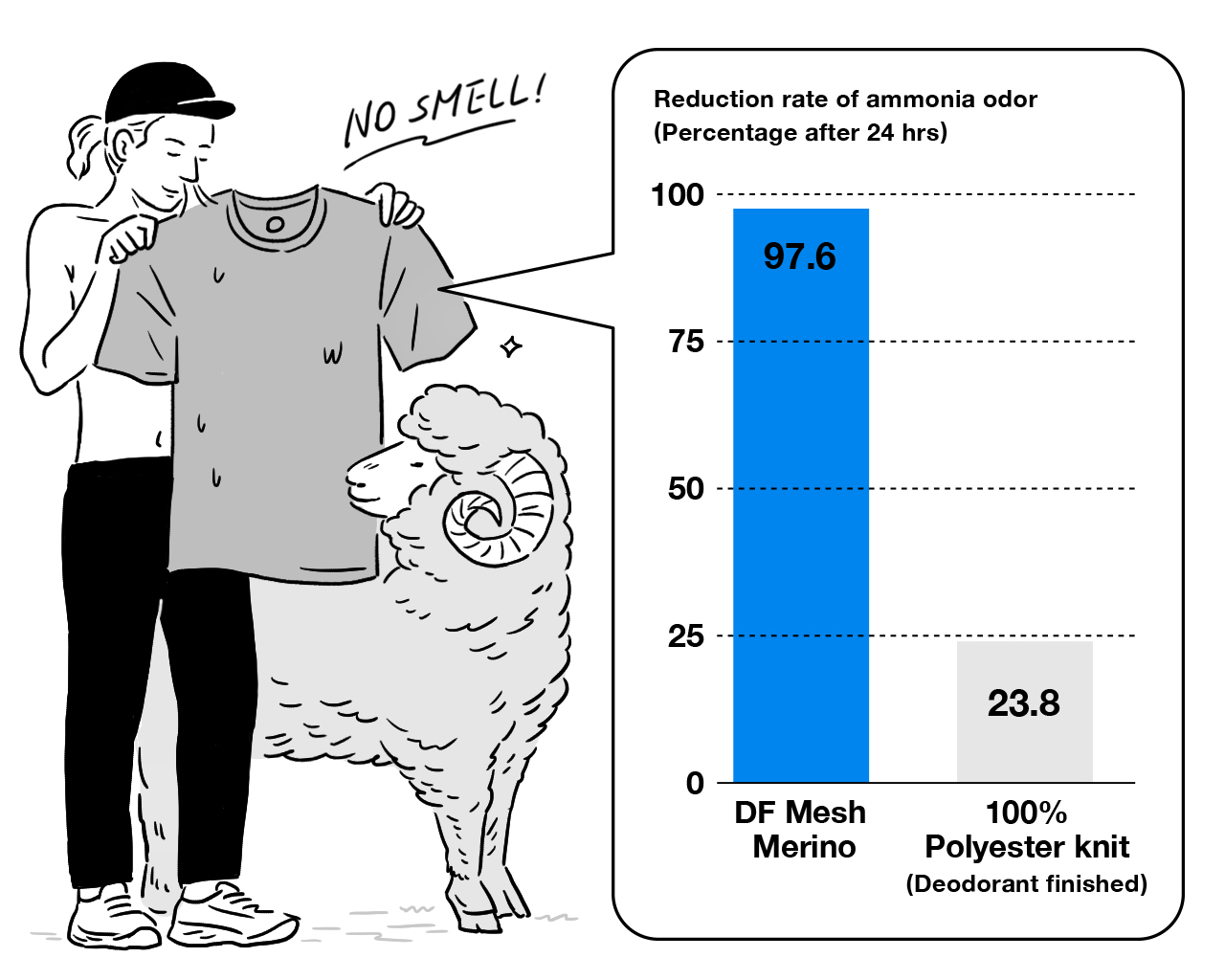
Wool’s deodorant mechanism is still a mystery. One theory has it that wool absorbs a large amount of odor-causing elements, and consequently, the odor is minimized to the level that cannot be detected by the sense of smell. We will conduct our own experiments and tests in the future.
Great moisture control
Wool is great to help you keep warm and cool as it naturally controls the moisture level within the clothes, always keeping you comfortable throughout the year.

Wool’s peculiar function is the benefit of the dead-air space between the crimped wool fibers, allowing for excellent breathability and moisture permeability. Furthermore, the cortex’s water absorption performance variably changes according to the humidity level of the outer air, that is, the higher the humidity outside, the more moisture it absorbs.
Even warm when wet
First, when wool absorbs moisture, the thermal phenomenon called “absorption heat” is generated. Secondly, its excellent insulation properties (low thermal conductivity) prevent the body heat from being lowered by evaporation. Also, the crimped fibers are bouncy and retain loft without crushing even when wet.
In addition, wool can absorb more moisture in between the fibers, always keeping the skin dry and comfortable.
Consequently, 100% Merino wool keeps you warm during the action, even in severe weather that makes you wet to the skin.

When fibers absorb moisture, the thermal phenomenon called “absorption heat” is generated. The wool’s adsorption heat performance is twenty times of polyester, and 2.5 times of cotton.
Wool's disadvantages
As explained above, wool or merino wool has various features and functions, but it is not flawless.
- Easily absorbs moisture and becomes heavy
Wool can get quite heavy as it is great at absorbing moisture. This also means that wool takes longer to dry than synthetic fibers, but compared to cotton, it actually dries faster.
- Liked by insects
Soft, natural fibers such as wool, cashmere, and silk are prone to damage by insects.
- Easily damaged
The relatively short fibers of wool mean that wool fabrics are easier damaged than synthetic and cotton fibers. However, small holes can easily be fixed with a bit of pure wool and a needle.
- Shrinks easily
Wool generally shrinks easily, even when shrink-proofed. To reduce shrinkage, after the wash, please spread the shirt well to return to its original shape and gently iron it.
- Distortion
When knitted wool fabrics are washed, the material is likely to distort diagonally because the yarned fibers absorb water, swell, and tend to untwist. Consequently, the shape of the shirt may distort slightly with washing.
- Distinctive smell
The wool comes from sheep and you may experience a distinctive animal-like smell coming from your t-shirt when damp. This smell usually disappears after the fabric dries.
The above information was compiled and edited based on the interview with the textile company and the research institute, and the reference book below:
Bibliography:
Structure and Physical Properties of Wool, Japan Wool Industry Association, Seni Co., Ltd.
Details
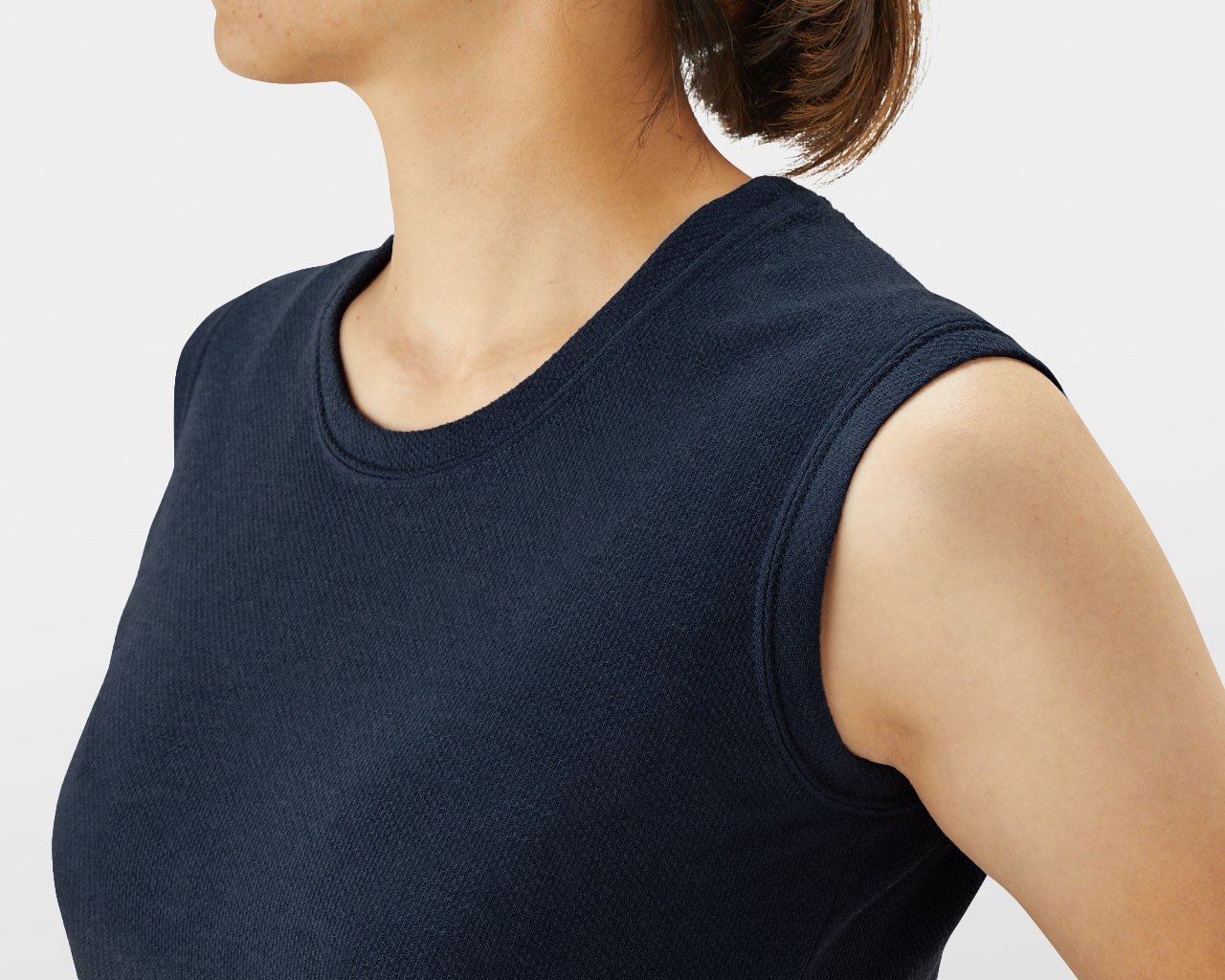
The neckline and armhole pipings use the same fabric.
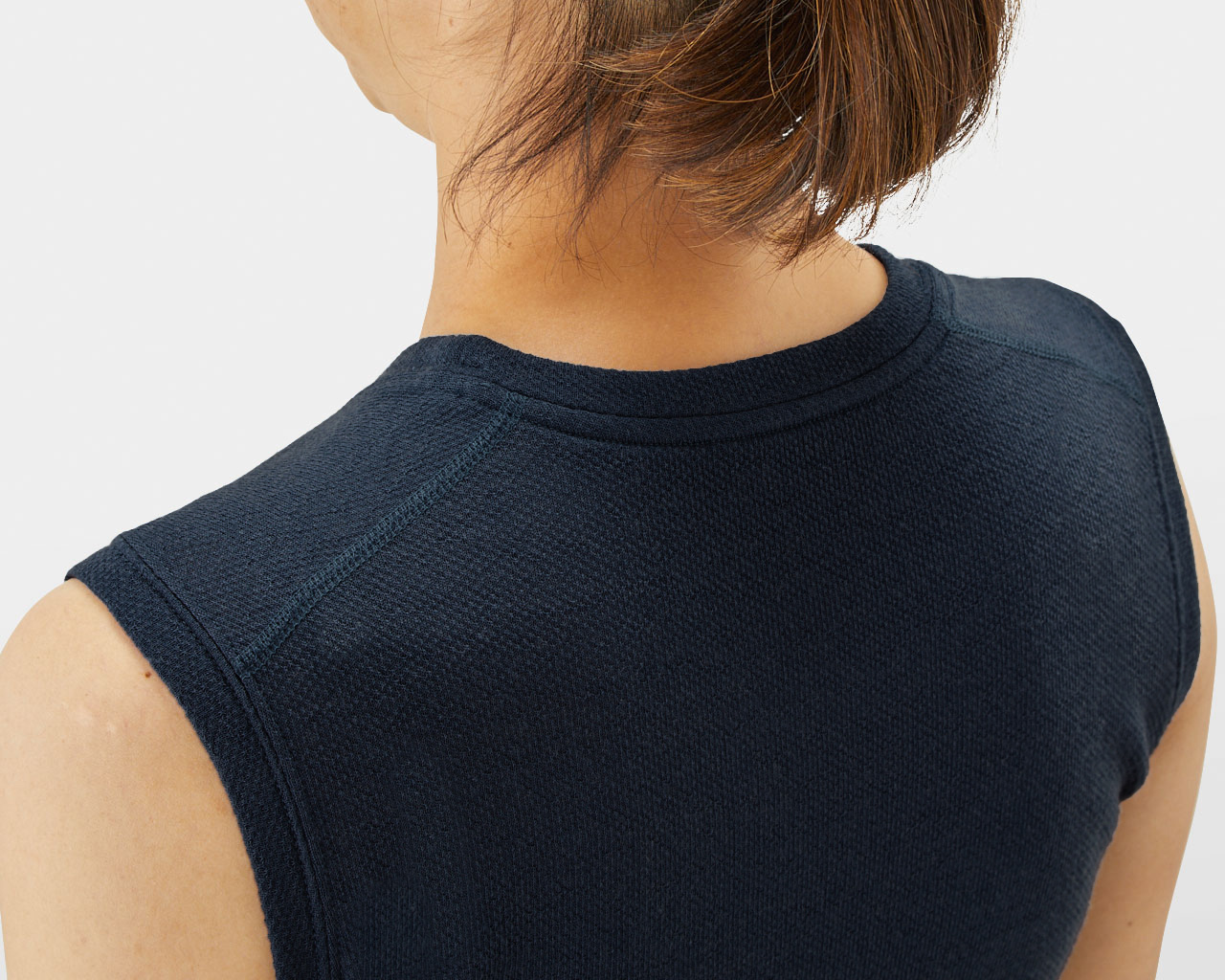
The shoulder is flat-sewn at the back of the shirt to prevent the irritation caused by the friction with the shoulder strap.
Product review
In 2023, Yamatomichi staff member JK (Jun Nakamura) completed the Continental Divide Trail (CDT), one of the three great long-distance trails of North America.
In this feature, JK shares his impressions of our gear after the nearly 5,000 km journey, alongside reviews from long-distance hikers and mountain endurance athletes who tested the products during development, as well as insights from our HLC ambassadors.

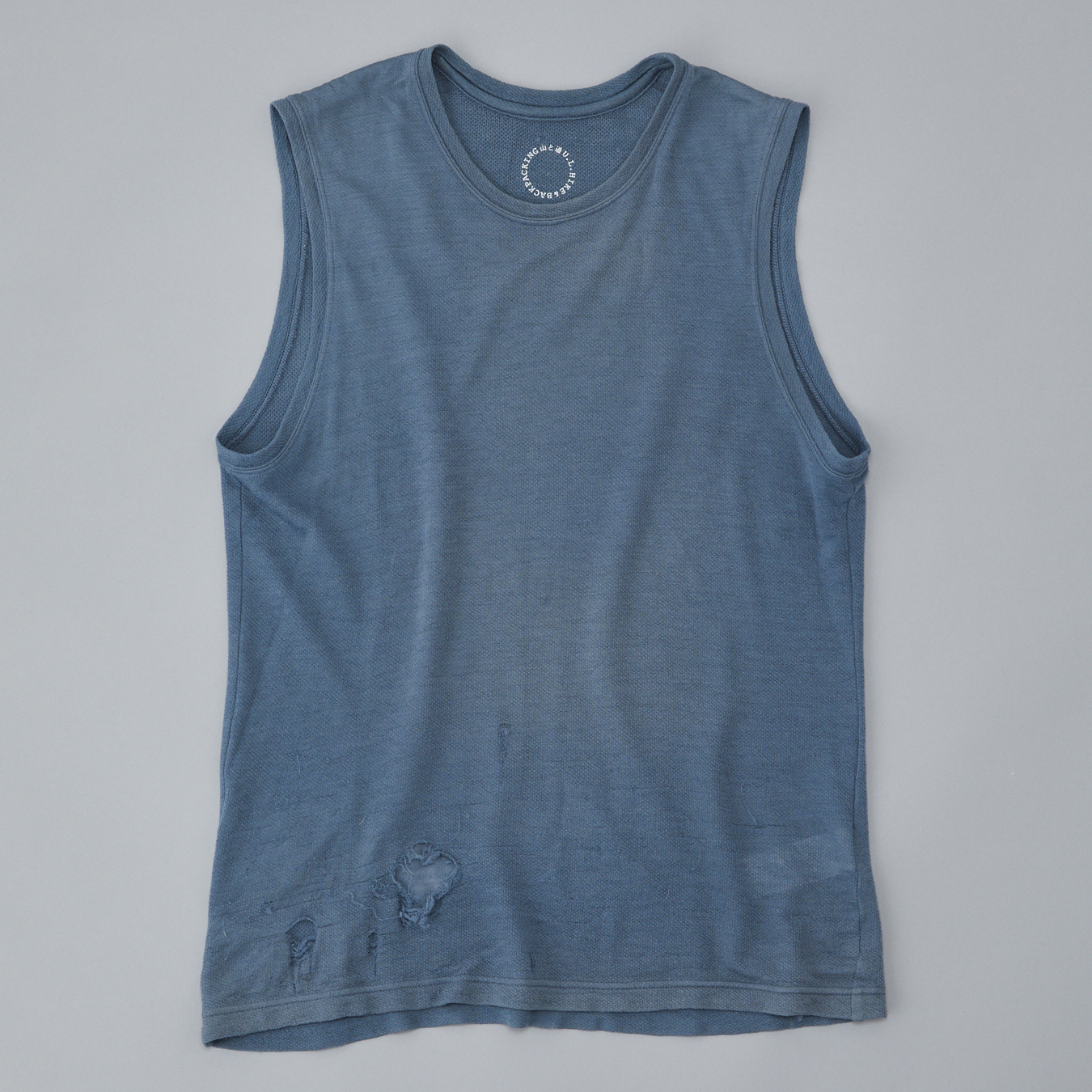

Even when I was sweating, the DF Mesh Merino Sleeveless never felt clingy against my skin. During breaks, it would dry quickly from my body heat and the wind. On the CDT, it wasn’t uncommon for humidity to drop as low as 18%, which accelerated the drying even more—I remember the fabric feeling dry and comfortable the whole way through.
That said, the fabric didn’t come out unscathed. Friction from my hip belt eventually created a hole around the lower front area, and the material around my waist had worn so thin that the double-face (DF) knit had basically become single-face (laughs). I didn’t take any special care with washing either—no laundry net, no delicate cycle. I just tossed it in with everyone else’s clothes and ran it through the dryer full blast.
Still, it held its shape surprisingly well and never became unwearable. It was one of those key pieces that kept me comfortable from start to finish on the long trail.

International Communications / YouTube
Yamatomichi Staff, completed the 4,250km Pacific Crest Trail (PCT), which spans from Mexico to Canada through the United States. Walking this trail made Junki realize the importance of ultralight hiking and joined Yamatomichi later that year. Since then, Junki has been learning and practicing ultralight hiking through Yaamtomich, refining and deepening his ultralight mindset. This year, in 2023, Junki completed the Continental Divide Trail (CDT).
Instagram: @junki.hiker
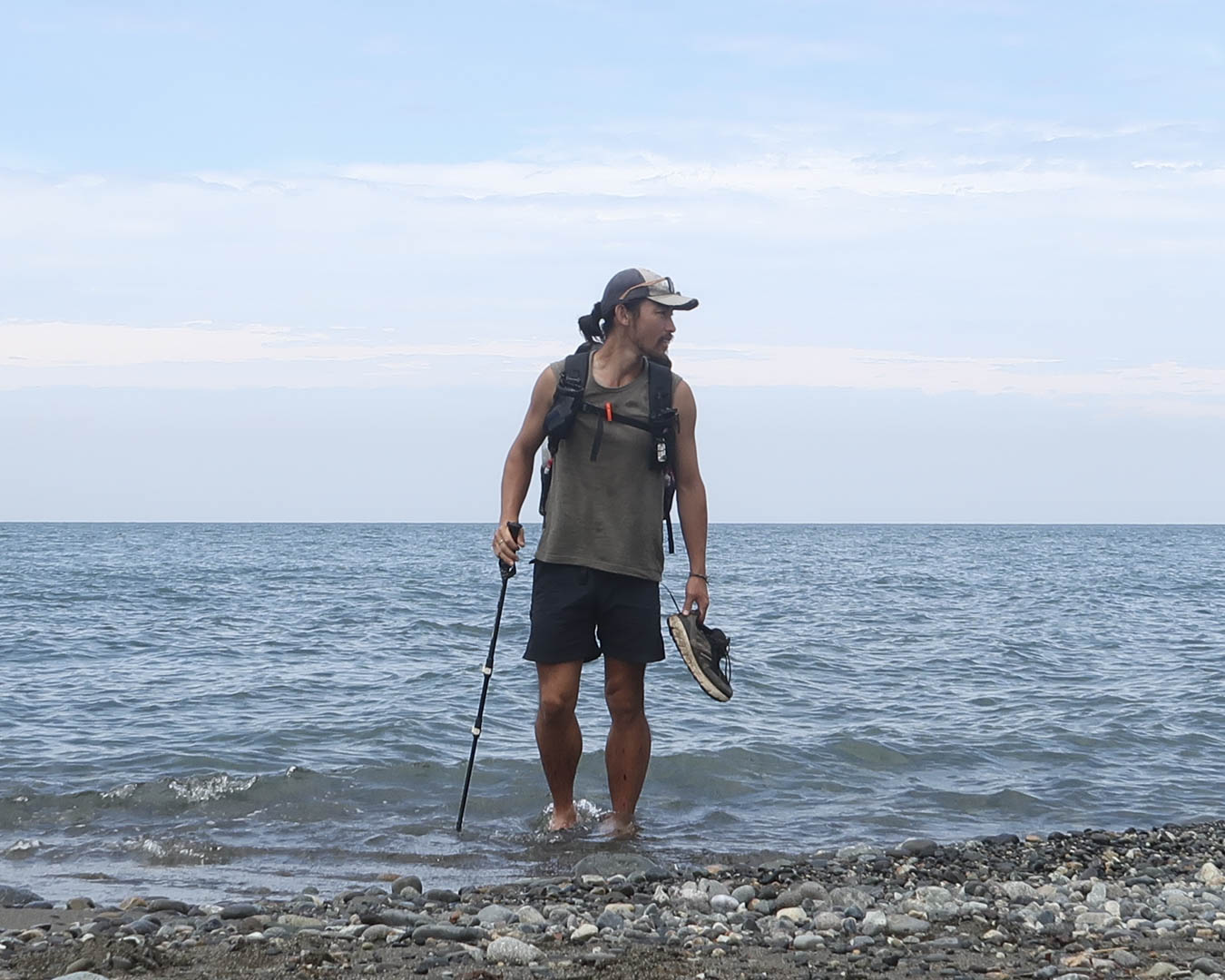
I wore the DF Mesh Merino almost every day during a 23-day summer journey across Honshu. From long road walks to alpine sections above 2,000 meters, it performed consistently well in all kinds of conditions.
On road sections or the initial climb into the mountains, I would be drenched in sweat, but the shirt never stuck uncomfortably to my body or restricted my movement. Even when it was wet, I felt reassured knowing it would dry quickly—so much so that I often skipped putting on rain gear in light showers and just kept walking.
When the wind picked up along a ridge or I started to feel chilled from sweat, layering something fast-drying like the UL Shirt over it helped retain warmth while speeding up the drying process. Even at the end of the day, once I was in my tent, I could keep it on and let it dry while I rested.
Personally, I think this piece will be a go-to base layer during the warmer months—from spring through fall.

Long-Distance Hiker / Owner of Cafe & Bar peg.
In 2013, he cycled around Japan. In 2014, he spent a working holiday in Australia. From 2015 to 2016, he traveled around the world. He thru-hiked the Pacific Crest Trail in 2017, the Appalachian Trail in 2018, the Continental Divide Trail in 2019, and the Michinoku Coastal Trail in 2020.
He shares the lessons and inspiration gained from his journeys and time in nature through social media and audio platforms like podcasts.
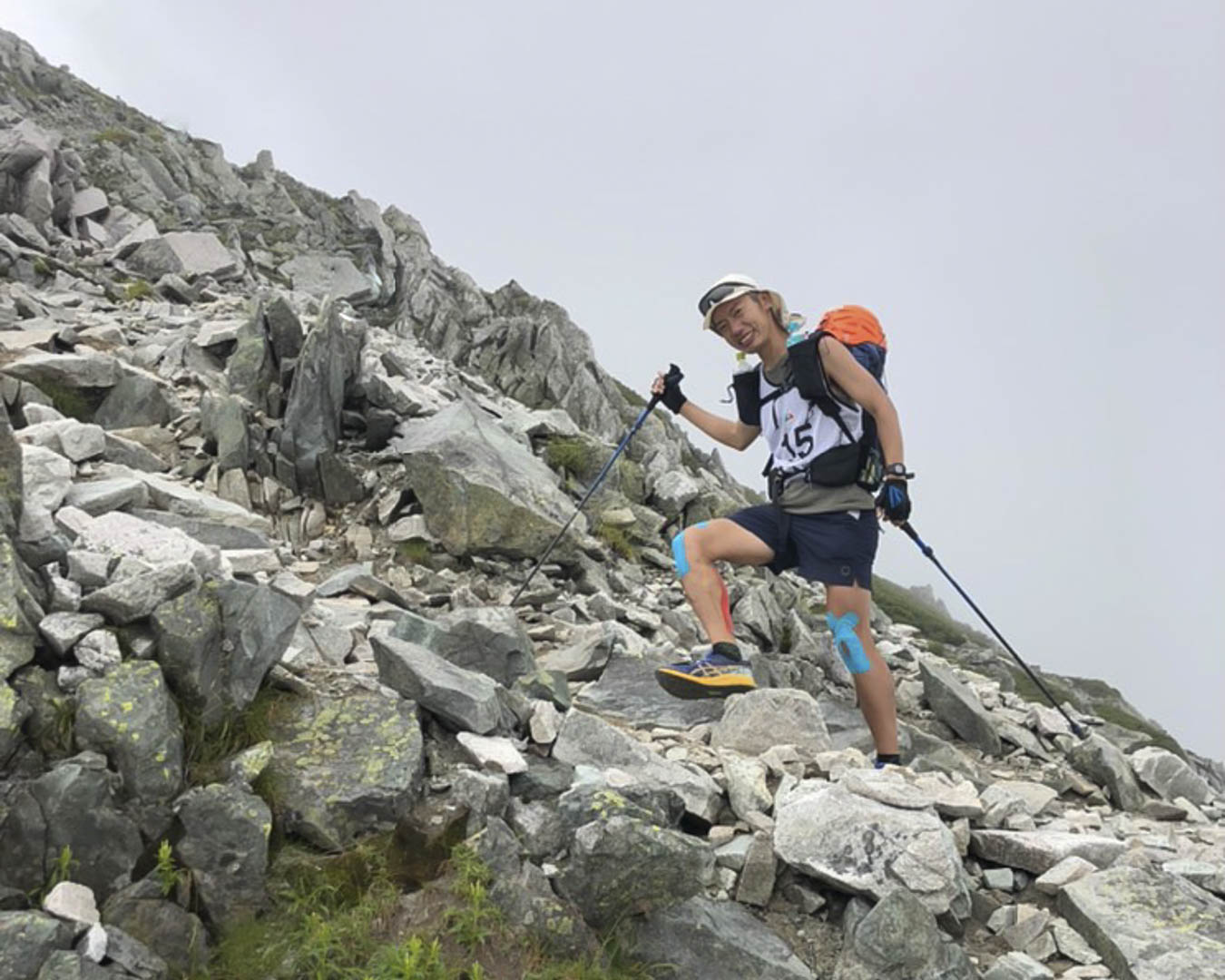
I wore the DF Mesh Merino during the Trans Japan Alps Race (TJAR) held in August 2022. Initially, I was concerned that wool might trap too much heat on hot days, but the fabric allowed just the right amount of heat to escape through the sides. Even when sweating, it didn’t cling to my body, and I stayed comfortable even during long road sections in the daytime.
Up on the alpine ridgelines, the airflow made it feel pleasantly cool, and the texture was soft enough that I could wear it without a mesh base layer underneath—which I really appreciated. I thought it might get chilly at night without an extra layer, especially when wet, but I never felt cold even after getting soaked.
That said, I did notice wear and tear where my pack’s harness rubbed—particularly around the waist—which made me feel that the surface durability isn’t very high. This piece seems best suited for situations where minimizing gear is important or during the early autumn season when you begin to feel a chill in the air.
Beyond hiking, climbing, and fishing, I think it’s also great for cold-season running (especially with sleeves), or as a base layer for everyday wear in fall and winter.

TJAR2022
He completed the Trans Japan Alps Race (TJAR) in 2022, after first participating in 2020.
His passion for mountaineering began in 2012, and he started enjoying weekend hikes around the Tokyo area. In 2014, he was deeply inspired by Great Traverse: One Continuous Journey Through Japan’s 100 Famous Mountains, and learning that Yohei Tanaka had competed in TJAR sparked his interest in the race.
Attending a TJAR debriefing session in 2016, he was captivated by the athletes’ incredible skill and human spirit, which motivated him to begin training seriously. Though he was not selected in the 2018 qualifier, he made his first appearance in the 2020 TJAR. Unfortunately, the race was canceled at Nishikama Ridge due to severe weather.
In 2022, he finally achieved his long-held goal of completing the TJAR.
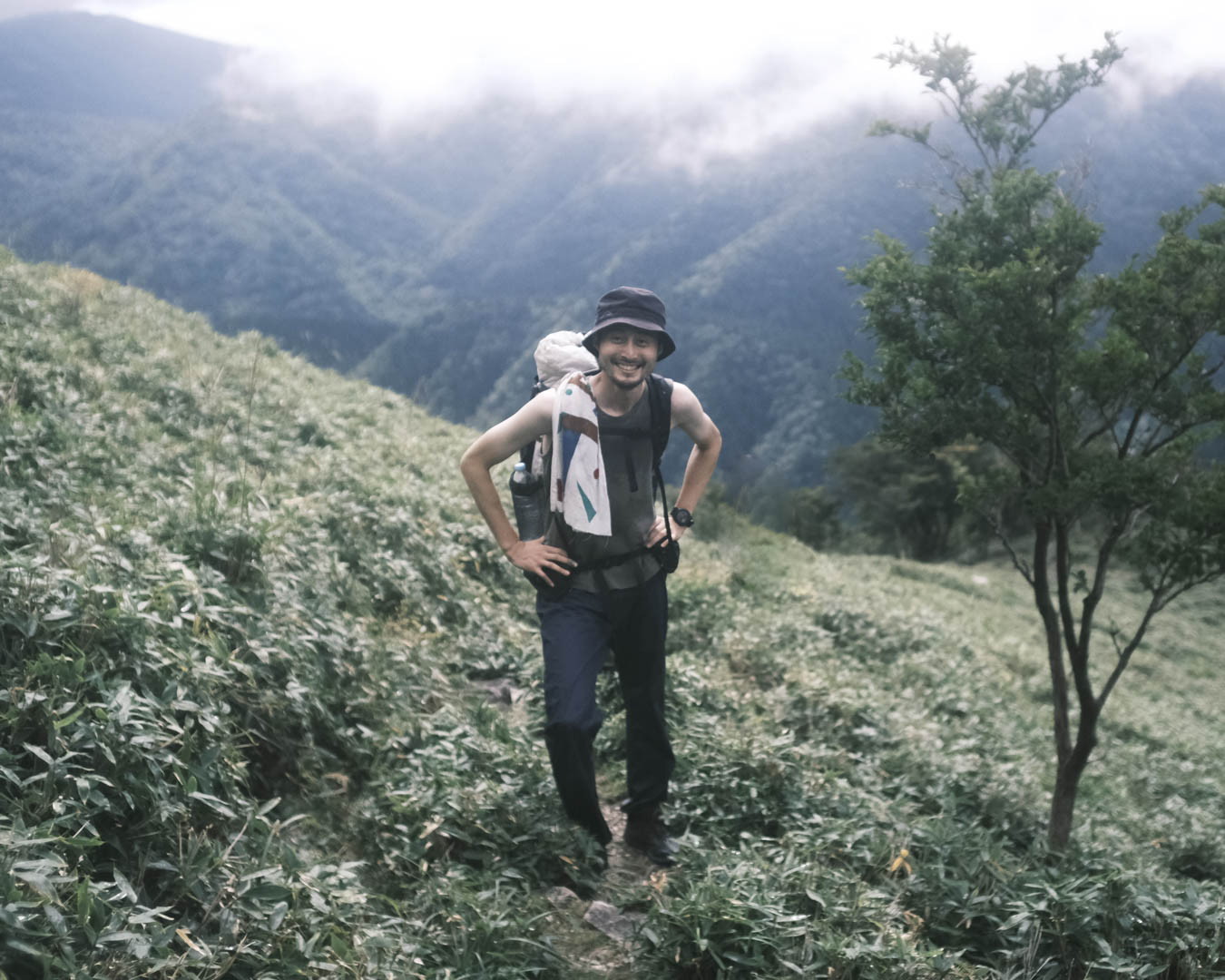
I wore the DF Mesh Merino Sleeveless during a week-long hike across Shikoku in mid-September. Even when it was soaked with sweat during sunny daytime hikes, it barely clung to my skin and didn’t feel uncomfortably wet. When putting my pack back on after a break, I noticed very little chill from the damp back panel—sometimes it dried so quickly during rest stops that I almost forgot it had been wet at all.
During rain or cooler times of day, I layered the UL All-weather Jacket over it. Even when I got completely soaked in heavy rain, the comfort level remained surprisingly high.
That said, because the fabric lifts off the skin easily, I did feel chilly when resting in windy spots—so I’d recommend putting on a layer early in those situations.
Because it resists the sticky, chilling feeling of sweat, I found it ideal as a base layer even in warm conditions. At the same time, I’m curious to test how it performs in colder seasons when layered with other pieces.

Yamatomichi HLC Kita-kanto Ambassador & Outdoor Shop Lunnetes Staff
He first discovered the mountains at age 20, captivated by an indescribable feeling while hiking Mt. Nasu with a friend. His journey into UL culture began with a Yamatomichi sacoche—and soon after, he found joy in MYOG (Make Your Own Gear), learning the thrill of heading into the mountains with equipment he crafted himself.
After leaving his job at a camera manufacturer, he joined the staff at LUNETTES. In addition to hiking, he’s also passionate about fly fishing and telemark skiing.
Material
What to wear is an eternal challenge. In highly intensive activities in conditions with large differences in temperature, you feel too warm and stuffy if the clothes are too warm, while increased breathability could lead to the risk of being too cold.
We recommend 100% merino wool fabrics with excellent moisture control, heat retention, deodorant, and resistance to cooling when wet, etc. However, we have to admit that there have been cases where merino wool is not comfortable, especially when it’s too warm and you sweat heavily. The DF Mesh Merino is the proprietary fabric that we have developed over the past two years to overcome these issues.
The DF (double face) is a dual-layer mesh structure; The skin side is a mesh made of 100% merino wool and is hydrophobic-finished to keep the water away, contacting your skin by points rather than by a single layer to keep you always comfortable. The surface side, on the other hand, is flat-knitted and hydrophilic-finished for better sweat absorption. The fabric is made of synthetic/merino yarn, that is, a nylon core wrapped by the merino yarn to increase durability and quick-drying properties. As such, the double-face fabric keeps you dry and offers you maximum comfort even under the changing weather.
The excellent air permeability will keep you cool when you are on the move while keeping you warm when you stand still. It is even warmer if you wear a windproof jacket. As a result of the wool blend ratio being approximately 90%, it also exhibits excellent natural-derived properties such as deodorant and moisture control.
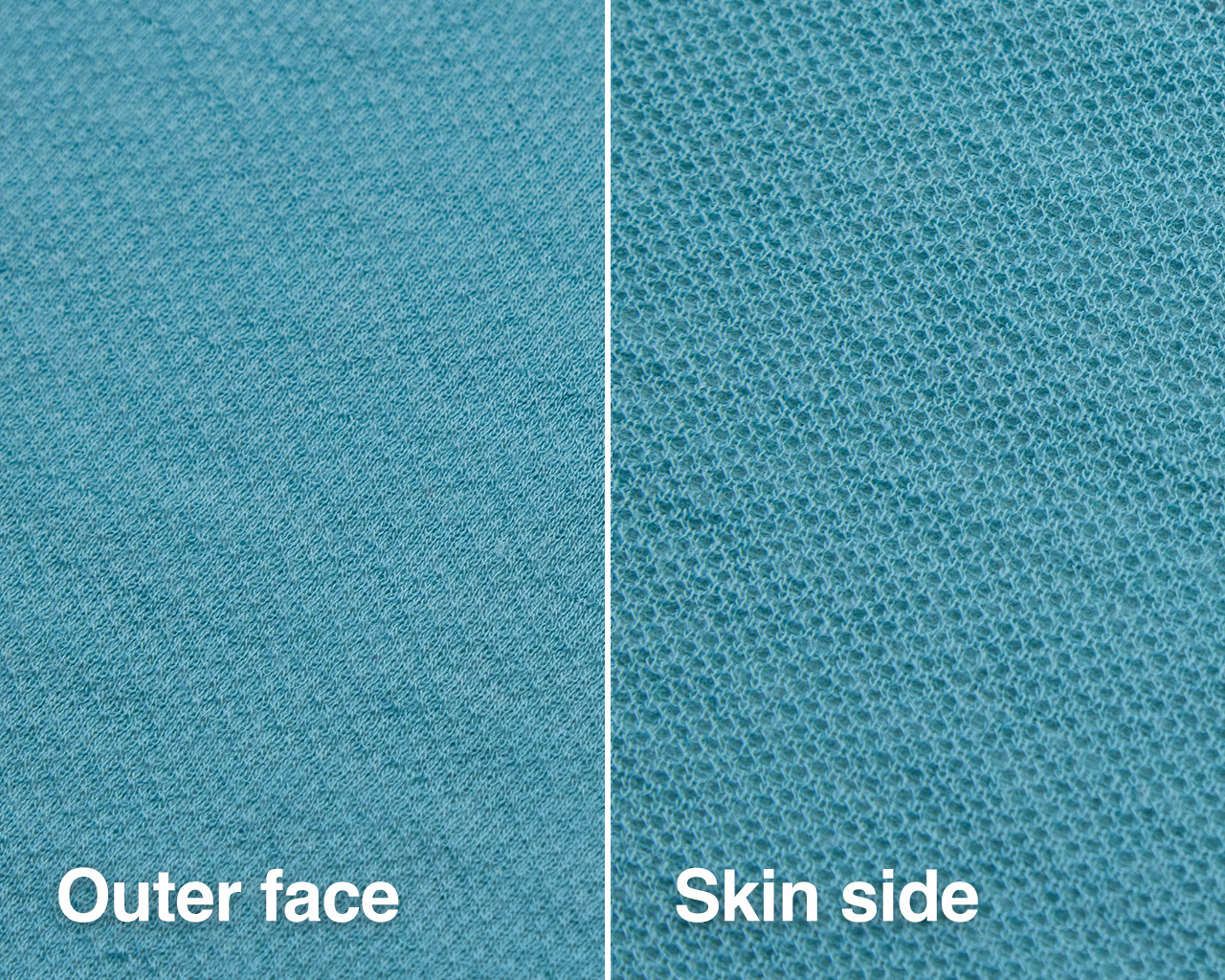
Size guide
Size chart
| Size | S | M | L |
|---|---|---|---|
| Weight (kg) | 42~49 | 47~56 | 54~62 |
| Chest (cm) | 78~84 | 82~90 | 86~94 |
Product dimensions
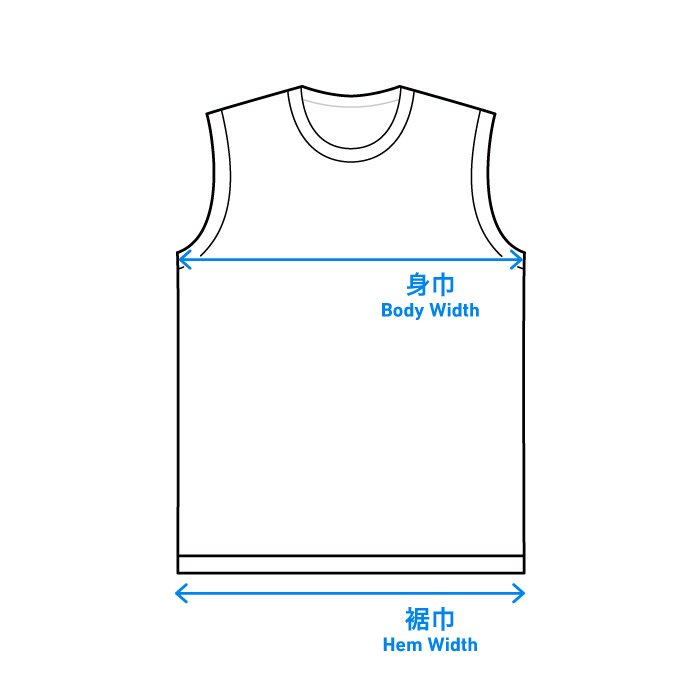
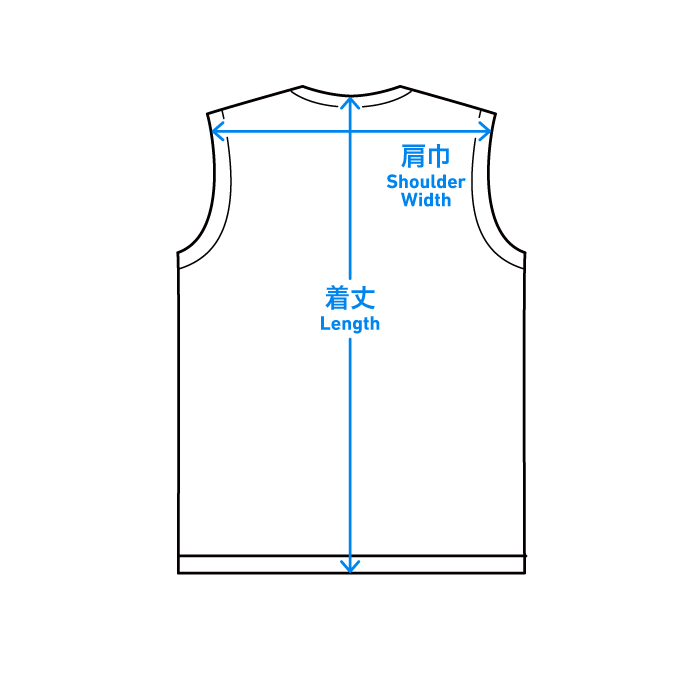
Unit:cm
| Size | S | M | L |
|---|---|---|---|
| Length | 62 | 64 | 66 |
| Shoulder Width | 32 | 34 | 36 |
| Body Width | 40 | 42.5 | 45 |
| Hem Width | 38 | 40.5 | 43 |
The measurements above are based on the unwashed product at the time of purchase.
- Due to the nature of stretchable knit fabric and slight variations in sewing, actual dimensions may differ slightly from the listed sizes.
- The fabric may stretch with wear and shrink after washing. The amount of change can vary between individual garments.
- Shrinkage may also vary depending on the type of washing machine and the settings used.
- If the garment feels smaller after washing and drying, you can help restore its shape by gently stretching it while using a steam iron.

Our DF Mesh Merino Series have a wide-fit, standard-fit and slim-fit: DF Mesh Merino Sleeveless is slim-fit.
Fitting
Note before use
Durability
The DF Mesh Merino has an uneven mesh-like surface structure, which can easily develop snags, pillings, and holes by the friction with the backpack straps if it is worn by itself.
Wool is a short fiber material that tends to lose fibers when rubbed against something coarse and hard. It is relatively thin and prone to holes compared to synthetic fibers or cotton. Therefore, the DF requires more care than normal woolen knit fabrics when you walk in the bushes or rocks, or when it is in contact with hard mesh.
Please wear a shell jacket or shirt over it instead of wearing it alone if you use it in a hard situation. The DF fabric is highly breathable and allows the wind to permeate easily, so wearing a shell jacket is a great idea to keep you warm.
Potential color transfer
Please note that color may transfer if this product comes into contact with white or light-colored garments when wet from sweat or rain.
Instructions
Care instructions
- Please wash separately or use the laundry net bag.
- Mesh fabrics are prone to deform or distort. After washing, adjust the shape of the product and dry it flat.
- Hydrophobic and hydrophilic properties are added in the later process and are not natural. They may be weakened with use.
- When you store the item, use mothballs and/or vacuum storage bags to keep out insects.
Care instruction page
For more detailed washing, drying and water repellent care instructions, visit our SUPPORT Page. With proper care you can prolong the funtionality of the product.
Payment
- We only accept payment by credit card. We currently do not accept payment via bank transfer from overseas accounts.
- We accept the following Credit Cards: Visa, Master, American Express, and JCB.
- To download your receipt, please click the link included in the Dispatch Notice, which we will send by email as soon as the items are dispatched.
- Bank transfer is only availble for those that own a Japanese bank account.
Delivery
- Order Confirmation will be sent after the order.
- The items will be dispatched within 3 days after the payment is confirmed.
- The dispatch notice will be sent by email as soon as the items are dispatched.
- The delivery may be delayed by unforeseeable reasons such as natural disasters and other logistics issues. We appreciate your patience and understanding.
- We cannot ship multiple orders in one package due to how our delivery system is currently set up.
- We will ship to regions in North America, Oceania, and Europe (excluding Russia) via DHL. For regions in Asia, the Middle East, Central and South America, Africa, and Russia, we use EMS (International Express Mail Service) for shipping.
- Shipping fees and delivery times vary depending on the shipping destination as well as the size and weight of the items.
Size exchange
- Overseas customers who need to change the size of their order, should note that the time needed for shipping will vary greatly depending on your country of residence.
- We only accept exchanges when the item is unused (except for fitting).
- If you wish to exchange the size of the item, please contact us within seven days of receiving your order.
- Exchanges can only be made for the same color in a different size.
- If the size you wish is out of stock, we will suggest a different color.
- If the product is out of stock, we may simply have to ship the item back to you.
- All shipping costs to be carried by the customer.
- We will only send the exchanged item to you, upon receipt of return shipping cost via PayPal.
- Please be aware that some countries charge customs duties depending on the price of the item.
- We are unable to answer any questions on local customs. Please contact your local customs bureau.
Repair
We accept repairs for all of our Yamatomichi products. For inquiries on repair services including patching the holes, repairing with extra components, or fixing the items damaged over time, please feel free to contact us from the “Repair” section of the SUPPORT page.







